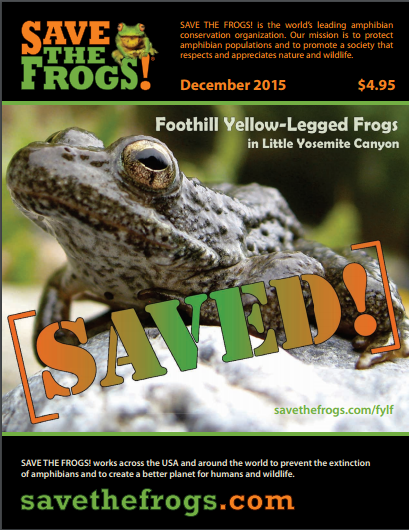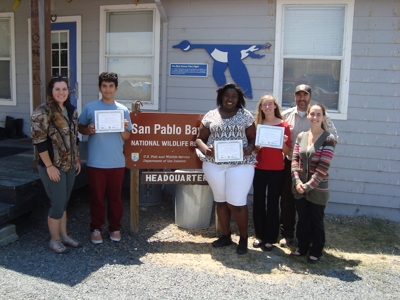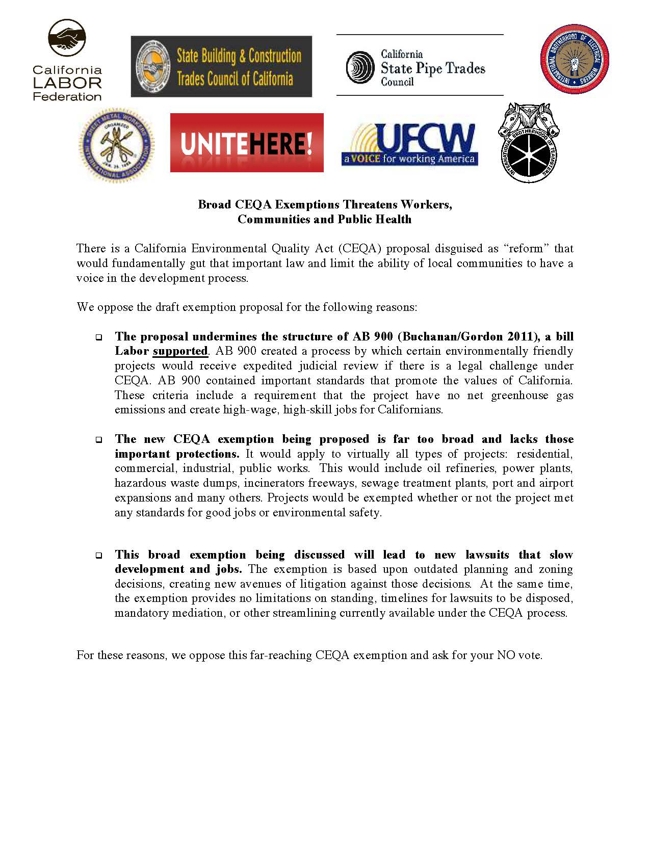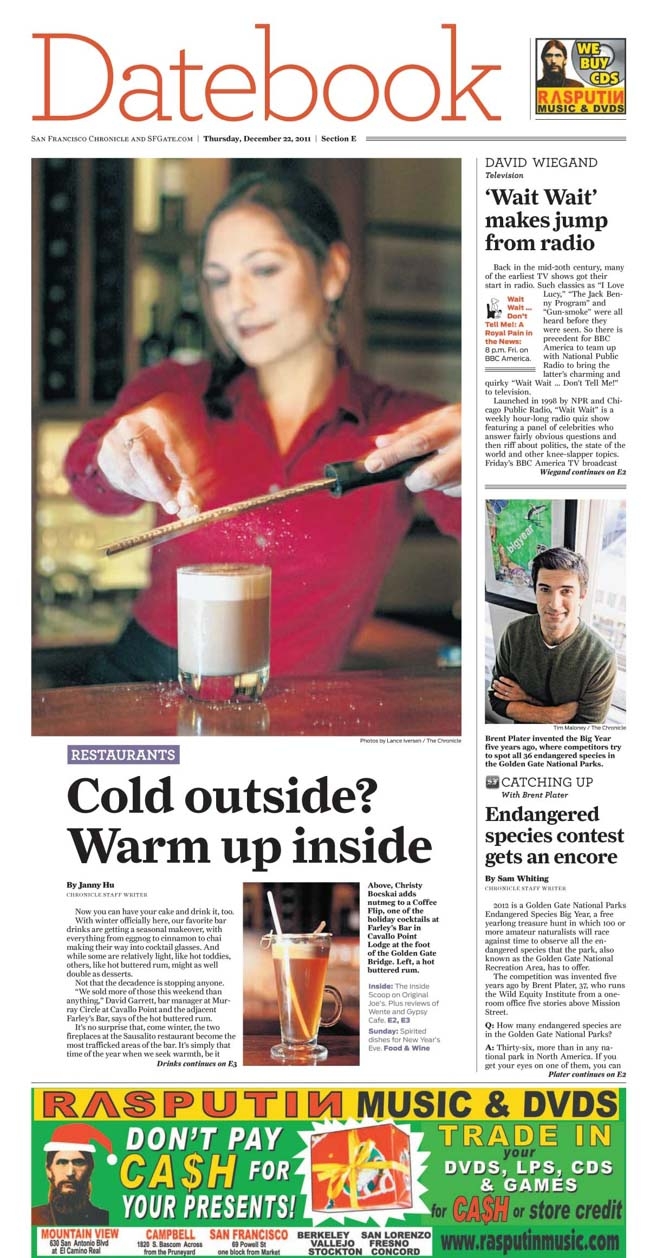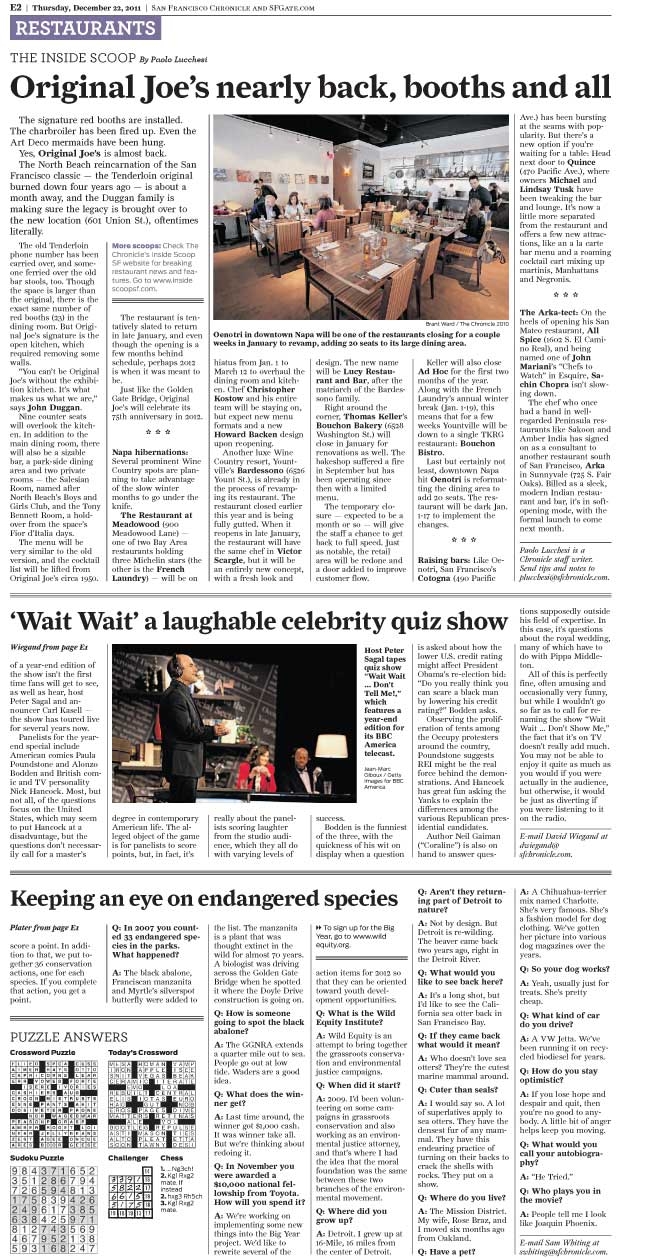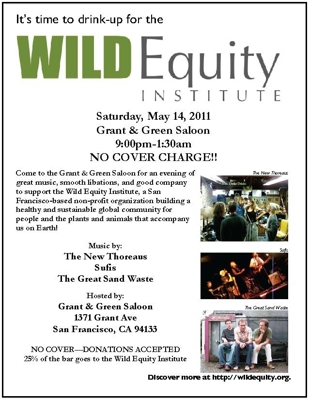Tag Archive for: About Us
Equity (ěk’wĭ-tē) n. 1. The state, quality, or ideal of being just, impartial, and fair.
The Wild Equity Institute is a San Francisco-based non-profit organization that builds a more sustainable and just world, both for people and the plants and animals that accompany us on Earth. Our work protects local endangered species and defends underserved communities through innovative education programs, science-based administrative petitions, and vigorous enforcement of environmental laws.
Wild Equity Institute Executive Director Brent Plater describes why he founded the organization and what he hopes to accomplish with the group.
Wild Equity was founded in 2009 after several years of community organizing to link the grassroots conservation movement and the environmental justice movement through the movements’ shared moral foundation: equity, the desire for a more just and fair world.
The environmental justice movement’s focus on the inequitable distribution of environmental hazards—and increasingly, its focus on the inequitable access provided to environmental goods like open space and parks—is clearly an example of a movement working towards a more equitable society. Similarly, the grassroots conservation movement works to remedy an inequitable relationship: between our human communities and the non-human world. As we consume a greater share of the world’s finite resources, less remains for the plants and animals around us, driving thousands of species to the brink of extinction. While the moral consideration we owe to each other may be different in kind and scope to what we owe to other forms of life, in both cases the gap between what our moral foundation suggests we should do and how we actually act leaves us with a culturally isolated and biologically impoverished world.
The Wild Equity Institute’s purpose is to unite these two occasionally disparate environmental movements into a powerful force that creates a healthy and sustainable global community for all. We accomplish this by working on projects that highlight and redress the inequitable relationships across our human communities while improving our relationship to the lands in which we live.
Hear what program officers from around the Bay Area think about our work.
The Wild Equity Institute is a California non-profit corporation and is registered as a 501(c)(3) public charity with the Internal Revenue Service. We are supported by the Rose Foundation for Communities & the Environment, the Fund for Wild Nature, the California Wildlands Grassroots Fund, the Firedoll Foundation, the Jeff & Connie Woodman Foundation, the Foundation for Youth Investment, the JiJi Foundation, TogetherGreen (a collaboration between National Audubon Society and Toyota), the Society for Community Work, the Foundation for Ecology & Culture, REI’s San Francisco store, the Sports Basement, the NITA Foundation, Patagonia San Francisco, and hundreds of community members just like you. Join us: become a member of the Wild Equity Institute today.
Board of Directors
Dr. Douglas Bevington
Rose Braz – Chairperson
Neal Desai
Ken Masters – Treasurer
Brent Plater – President & Executive Director
Anna Sylvester – Secretary
2014 has been a challenging year. On December 20, 2013, Rose Braz—Wild Equity’s Chairperson, my wife, and the person I call “the greatest human I’ve ever met” without reservation—had a seizure. That Christmas Eve she was diagnosed with an invasive and aggressive form of brain cancer called glioblastoma.
It was the scariest moment we’ve ever faced.

Too many days were spent like this in 2014.
Our lives have been transformed. Rose has since had two brain surgeries and endured radiation and chemotherapy treatments. Much of my time has been dedicated to Rose’s care, and searching the literature for treatments that may fight this disease.
This time last year we knew next to nothing about brain cancer. Since then we’ve learned that many researchers now believe there will not be a “silver bullet” cure for glioblastoma. It is much more likely that a cure will be forged from several different treatments, each fighting a different aspect of the disease.
We transformed what we learned into a treatment “cocktail” that seems to be working. Rose’s latest scans are clear, and she’s still fighting fracking throughout California.
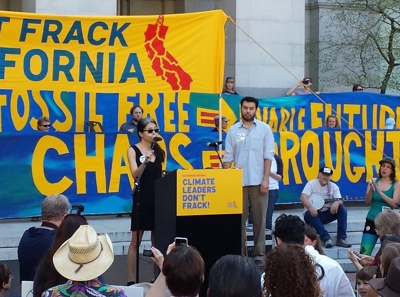
Rose rallying thousands just days after treatment.
What is most striking about this seemingly insurmountable challenge is that our struggles and insights parallel Wild Equity’s theory of change.
Wild Equity believes that no one strategy or technique will solve our systemic problems, so we wield a variety of tools—education, public relations, litigation, & grassroots organizing and lobbying—to win campaigns and create a sustainable and just world.
More so than any other Bay Area organization, Wild Equity has the suite of skills needed to wield each of these tools successfully, and we’ve demonstrated our effectiveness in wielding them time and again.
Now more than ever we need you to reinvest in our work: please renew your membership and/or make a tax-deductible contribution to the Wild Equity Institute today.
Even during this exacting year, your support has helped Wild Equity make great strides towards a more just and sustainable community for all:
- You helped us bring another lawsuit against the endangered species-killing Sharp Park Golf Course. With Save the Frogs! & Sequoia Audubon, Wild Equity is challenging Sharp Park Golf Course’s new attempt to drain critical wetlands for endangered species. With each successful claim we not only help wildlife, we increase the odds that San Francisco will stop wasting funds on this wildlife-killing golf course, and redirect them to San Francisco’s most impoverished neighborhood parks.
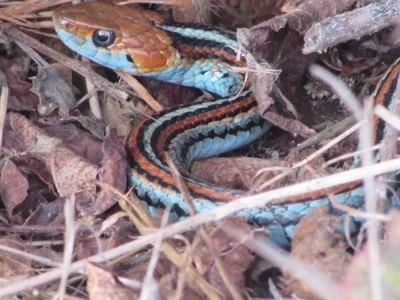
Photo © Liam O’Brien
- You helped us build our coalition against a power plant cluster adjacent to the Antioch Dunes National Wildlife Refuge. Wild Equity worked with the Fish and Wildlife Service and Antioch High School to introduce students to the remarkable, imperiled wildlife at the Antioch Dunes National Wildlife Refuge, and then fund three internships at the Refuge to help restore the Dunes ecosystem and spread the word about the threats the power plants pose to this remarkable place.
These victories are exceptional; with your support we can accomplish even more in 2015:
- Your contribution will create a better public park at Sharp Park, funding advocates who will fight for what you believe in at City Hall and in neighborhoods around the Bay Area.
- Your contribution will fund new legal challenges to the power plants that are polluting our communities and poisoning the Antioch Dunes National Wildlife Refuge, an investment that protects endangered species and our most vulnerable communities.
- Your contribution will help us expand the Endangered Species Big Year into an exciting new project: Wild Quest, a competition to see and save wildlife & plants around the Bay Area.
Imagine the world we will build together: a more equitable world for people and the plants and animals that accompany us on Earth. Thank you for supporting this vision and contributing to our work today!
With deepest gratitude,  Brent Plater, Executive Director 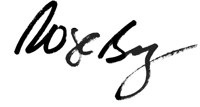 Rose Braz, Chairperson |
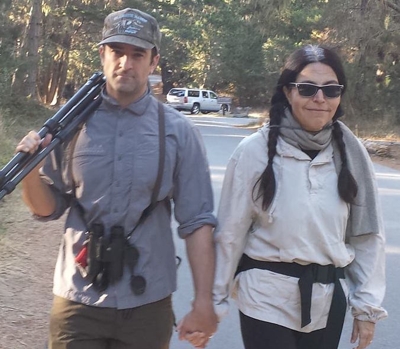 |
PS — Don’t forget to buy an “I ‘Bird’ SF” shirt for you and everyone you love! All sizes are currently in stock. Thank you!
Tonight’s the night: Wild Equity’s five year anniversary celebration! A limited number of tickets have been reserved for sale at the door for only $15, so come on by!
Thursday November 6th, 6pm,
at the Eric Quezada Center for Culture and Politics
Thank you from all of us at Wild Equity!
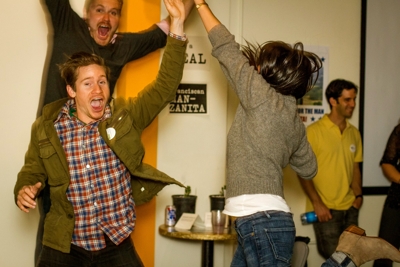
These are not actors: it’s an actual scene from Wild Equity’s most recent bash!!
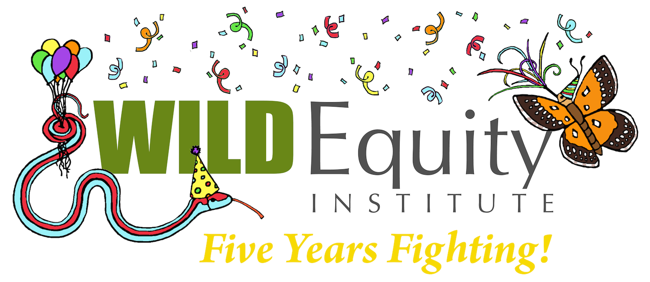
On November 6th, 6pm, at the Eric Quezada Center for Culture and Politics Wild Equity will be proudly celebrating our five year anniversary! That’s right, it’s already been Five Years Fighting, and we’ve decided to throw you, the people who’ve made Wild Equity possible, a party!
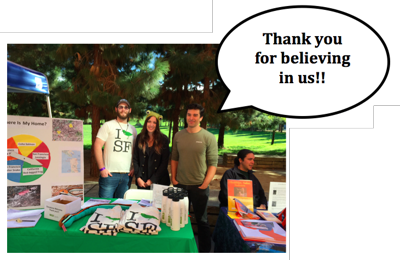
Please join us for food, drinks, games, goodies, and most importantly good company! We’ll have live music by singer/songwriter Kristin Plater, as well as an outdoor gear raffle and vintage endangered species artwork up for auction at this celebratory end-of-year fundraiser. We’ll also showcase what we’ve accomplished to date, and, of course, show how we intend to keep Wild Equity’s momentum growing!
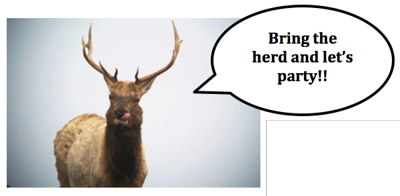
Tickets are on sale now for only $15! Space is limited, so reserve yours today!
(No one turned away for lack of funds.)
We can’t wait to see you!
Wild Equity Institute Staff Attorney Laura Horton ended a year-long project with the Toyota TogetherGreen fellowship program on August 8, 2014. Laura received a grant from the TTG program in September, 2013, and created a project that brought together high school students and teachers, government land managers, and environmental advocates in an effort to save the highly endangered Lange’s Metalmark Butterfly. The project centered around the Antioch Dunes National Wildlife Refuge, and Laura facilitated a two-part restoration program with Antioch High School students.
During the spring, Laura brought sixty students from Antioch High School to the Refuge to engage in native plant restoration and invasive removal. During the summer, Three students, Daja Miller, Adeeb Nazam, and Emily Hendricks, were awarded a summer internship with the Fish and Wildlife Service. The summer program included intensive hands-on training in land and wildlife management as well as a behind the scenes look at the California Academy of Sciences.
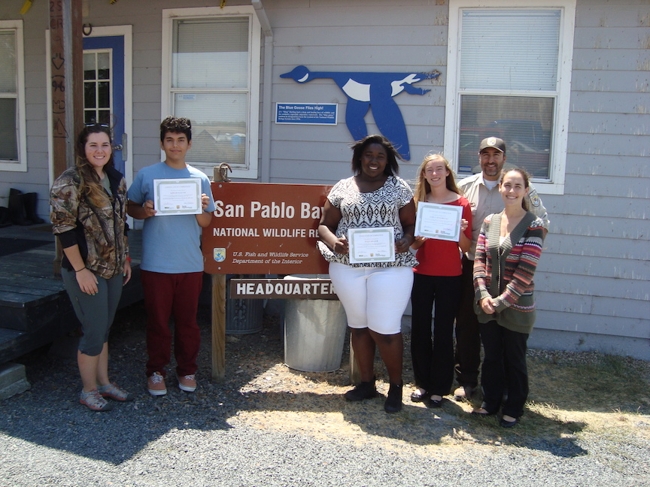
From L to R: Liz Reynolds, Adeeb Nazam, Emily Hendricks, Daja Miller, Louis Terrazas, Laura Horton.
On Friday, August 8th, the summer participants gathered at the Fish and Wildlife field office in Petaluma with friends and family to celebrate the successful program. Also in attendance were Laura and Fish and Wildlife employees including biotech Liz Reynolds and Wildlife Refuge Specialist Louis Terrazas, who acted as Refuge supervisors to the students.
Rick Barton, Environmental Studies Academy director at Antioch High School, plans to continue the relationship with Wild Equity and the Antioch Dunes National Wildlife Refuge in the future. Here’s to building new conservation leaders!
Thursday, July 10, 7:30pm, at the Randall Museum: San Francisco has 32 pockets of undeveloped land set aside for the preservation of the natural world. These pockets hold the last remnants of wildness once found across the lands where we now live, but do we have room in our parks and our hearts for nature in this city?
The San Francisco Natural History Lecture Series hosted by the San Francisco Naturalist Society welcomes Brent Plater, executive director of the Wild Equity Institute, for a photographic exploration of the remaining wild areas in San Francisco. Brent went on a three day quest to see each of these natural areas for himself, understand what’s proposed for these lands, and identify a plan to save these areas from the City’s mismanagement. Join Brent for a slideshow of his quest, add your thoughts to the conversation, and discover how we can help these areas thrive.
Please RSVP here or on our Meetup group page.
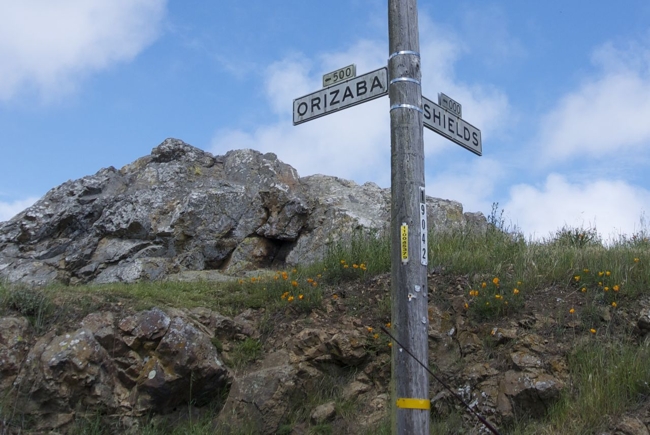
Lakeview/Ashton Mini Park Natural Area.

Staff Attorney Position
Position Summary.
Wild Equity is hiring a Staff Attorney to manage and prosecute environmental cases in state and federal courts. This full-time position is based in Wild Equity’s San Francisco office, and offers an extraordinary opportunity to join a growing organization and shape its future.
To apply for this position, please submit a resume, two recent samples of your own writing, list of references, law school transcript, and a cover letter describing your interest in our work to info@wildequity.org. The position will start on August 1, 2014.
Major Responsibilities.
Under the direction of the Executive Director and in collaboration with outside counsel, the Staff Attorney will:
- Evaluate new cases and identify administrative and litigation opportunities.
- Conduct legal research and writing.
- Prepare court filings and represent Wild Equity at oral argument.
In addition to these responsibilities, the Staff Attorney will also support partner organizations participating in our campaigns, represent Wild Equity at public meetings and in the media, write summaries of our cases for public distribution, and help with administrative and fundraising tasks.
Desired Qualifications.
- Juris Doctor degree.
- Admission to the California Bar or commitment to pass the California Bar.
- Excellent writing, research, and oral advocacy skills.
- Familiarity with key environmental laws such as NEPA, CEQA, ESA, and CAA.
- Demonstrated commitment to environmental and social justice.
- Strong work ethic with a keen attention to detail.
- Entrepreneurial spirit that desires responsibility.
- Advanced skills in basic computer programs such as Word, PowerPoint, Excel.
Salary and Benefits.
Salary will be commensurate with experience and litigation caseload. The total compensation package will be comparable to similarly sized non-profits. Wild Equity’s benefit package includes a flexible work environment, generous vacation time, medical insurance and commuter subsidies.
About Wild Equity.
The Wild Equity Institute unites the grassroots conservation and environmental justice movements in campaigns that build a healthy and sustainable global community for people and the plants and animals that accompany us on Earth. We accomplish this by working on projects that highlight and redress the inequitable relationships across our human communities while improving our relationship to the lands in which we live.
Representative projects include transforming an endangered species killing, money losing golf course into a new public park everyone can enjoy; working with conservation, environmental justice, and social service organizations to reduce emissions from power plants in Antioch, CA; and helping to build a more sustainable relationship between our communities and urban parks in the greater San Francisco Bay Area. To find out more, go to https://www.wildequity.org.
For Immediate Release, November 6, 2013
Contacts:
Laura Horton, Wild Equity Institute, lhorton@wildequity.org, (415) 235-0492
Agatha Szczepaniak, Audubon, aszczepaniak@audubon.org, (212) 979-3197
LAURA HORTON RECEIVES
AUDUBON TOYOTA TOGETHERGREEN FELLOWSHIP
Prestigious National Award and $10,000 Grant
Furthers Efforts of Local Environmental Leader
SAN FRANCISCO, Calif.— Toyota and the National Audubon Society today announced that a Toyota TogetherGreen Fellowship will be awarded to a San Francisco-based environmental attorney. After a competitive nationwide selection process, Wild Equity’s Laura Horton was selected for the year-long fellowship program and a $10,000 grant.
Audubon and Toyota select 40 high-potential conservation leaders to receive Toyota TogetherGreen Fellowships each year. With their $10,000 grants, Toyota TogetherGreen Fellows conduct community projects to engage diverse audiences in habitat, water or energy conservation. In addition to receiving support to help launch their conservation initiatives, Toyota TogetherGreen Fellows also benefit from specialized training and membership in a diverse national network of conservation professionals.
Horton will launch a project to engage high school students in the protection of local endangered species at the Antioch Dunes National Wildlife Refuge through education and restoration in collaboration with the Fish and Wildlife Service, Antioch High School, and past TTG fellows.
“This project will bring together students, teachers, refuge specialists, and activists in an effort toprotect the environment,” said Horton. “Wildlife and public health in Antioch are at risk and we will all work collaboratively to build a healthier and more sustainable community.”
The Toyota TogetherGreen Fellowship Program invests in conservation leaders of all backgrounds, providing them with resources, visibility and a growing peer network to help them lead communities nationwide to a healthier environmental future. Since 2008, 240 conservation leaders from across the country have been awarded Toyota TogetherGreen Fellowships. They have engaged nearly 150,000 people in a wide variety of conservation efforts nationwide.
“Toyota TogetherGreen Fellows help people engage with nature. They look like America: diverse, passionate and patriotic,” said Audubon President and CEO David Yarnold (@david_yarnold). “They are environmental heroes and we’re excited to give them a chance to invent the future.”
A complete list of 2013 Toyota TogetherGreen Fellows and details about their conservation projects can be found at www.togethergreen.org/fellows.
About Wild Equity Institute
The Wild Equity Institute unites the grassroots conservation and environmental justice movements in campaigns that build a healthy and sustainable global community for people and the plants and animals that accompany us on Earth. Our team of experts in law, management, design, and education accelerates the transition to this more equitable world through innovative, education programs, nature-inspired design, science-based petitions, and vigorous enforcement of environmental laws.
About Toyota TogetherGreen
Toyota and the National Audubon Society launched the Toyota TogetherGreen initiative in 2008 to foster diverse environmental leadership and invest in innovative conservation ideas. Toyota
TogetherGreen funding recipients have improved more than 30,000 acres of habitat, mobilized 420,000 individuals, conserved 15 million gallons of water and leveraged $10.5 million in volunteer hours. For more information, visit www.togethergreen.org.
The Wild Equity Institute is building a healthy and sustainable global community for people
and the plants and animals that accompany us on Earth.
Wild Equity’s web store is now live. Take a peak at our current offers below, and check the Wild Equity web store frequently for new items.
I “Bird” SF T-shirt, Only $20 + Shipping!
Share your love of San Francisco’s wildlife everywhere you go with Wild Equity’s exclusive “I ‘Bird’ SF” T-shirt! Made in the U.S.A. out of 100% organic cotton, the shirt features a silhouette of our City’s favorite puffball of feathers, the Western Snowy Plover. Wild Equity logo on the left sleeve too: to show your pride in our work! Comes in S, M, L, and XL in Unisex and Ladies Half-scoop designs. Specify your design and size choices by clicking on the corresponding buttons below.
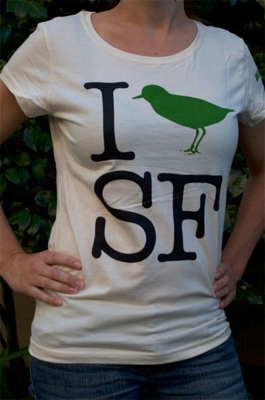 |
|
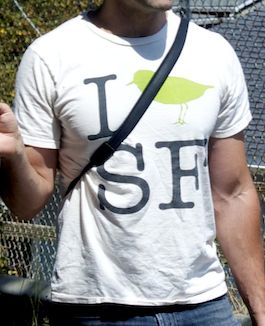 |
Wild Equity 100% Recycled Aluminum Bottle, Only $15 + Shipping!
These gorgeous Wild Equity-branded reusable bottles are made in the U.S.A. out of 100% recycled aluminum, and are lined with a BPA-free, non-toxic, food-grade coating to keep your drinks fresh and the bottle easy to clean. Comes in green or white: specify your color by clicking the corresponding button below.
 |
“What do you get out of it? Why do you keep trying?”
The reporter’s questions caught me off-guard. I had been expecting to discuss Wild Equity’s role protecting the Franciscan Manzanita—a gorgeous plant presumed extinct in the wild for decades, but now on the verge of reintroduction throughout the City. I hadn’t anticipated the need to defend my life’s purpose.
As my mind considered the questions, I realized that only my heart could answer them. “I get a chance to make the world more equitable, more beautiful,” I replied. “I know the odds are long, but thousands of people have trusted in our ability to make this vision reality. When I’m toiling away late at night, pouring over thousands of pages of government documents or pounding away at another legal brief, I reflect on how grateful I am for their support, and it makes all the sacrifices worthwhile.”
When the SF Weekly article finally came out, it emphasized Wild Equity’s work protecting this miracle plant, and noted that we’ve won “a number of other high-profile lawsuits in the name of conservation, including this summer’s triumph over Sharp Park Golf Course for killing endangered red-legged frogs and garter snakes.”
But it failed to note that these conservation victories aren’t ours alone. Your contributions—your commitment to our vision, your trust in our staff, your donations to our programs—make each victory possible.
As the SF Weekly recognized, we’ve had a remarkable year making a difference against incredible odds:
- You helped us prevail in our lawsuit against the endangered species-killing Sharp Park Golf Course. The judge ordered the golf course to pay $386,000 for its environmental crimes. This is the first time Sharp Park Golf Course has ever been held legally accountable for killing the California Red-legged Frog and the San Francisco Garter Snake. The ruling is a major step towards transforming the course into a National Park everyone can enjoy: including endangered wildlife.
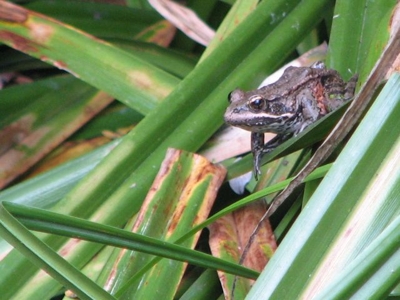
- You helped us win a $2 million dollar legal settlement from one of the five power plants that pollute low-income communities and the Antioch Dunes National Wildlife Refuge. The settlement will all go directly to mitigate pollution, as well as recovery efforts for the Refuge’s three endangered species: the Contra Costa Wallflower, the Antioch Dunes Evening Primrose, and the Lange’s Metalmark Butterfly, one of the most endangered butterflies in all of North America.
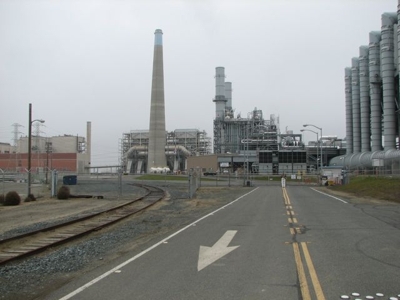
These victories are remarkable: with your support we can accomplish even more in 2014:
- Your contribution will create a better public park at Sharp Park, funding advocates who will fight for what you believe in at City Hall and in neighborhoods around the Bay Area.
- Your contribution can halt other power plants that are polluting our communities and poisoning the Antioch Dunes National Wildlife Refuge, retaining experts that will tell the butterfly’s story, before it is too late.
- Your Contribution will help us run our successful education project, the Endangered Species Big Year, and support our two new Big Year staff: Clay Anderson and Marcela Maldonado, as they build new park advocates people throughout the Bay Area.
Imagine the world we will build together: a more equitable world for people and the plants and animals that accompany us on Earth. Thank you for supporting this vision and contributing to our work today!
Thank you from all of us at the Wild Equity Institute,  Brent Plater, Executive Director with, from left to right: Amy Zehring, Community Organizer Marcela Maldonado, Project Coordinator Clay Anderson, Project Coordinator Laura Horton, Staff Attorney |
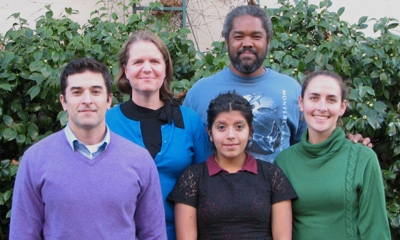 |
The wild Coho Salmon population found in Marin is about to vanish. In order to prevent this amazing fish from going extinct, we must restore riparian habitat and prevent destructive development. On Oct 29, the Marin Board of Supervisors ignored the plight of the salmon and passed an ordinance that will end a building ban in the San Geronimo Valley. Read more about this “unusual hearing” in the the Marin Independent Journal.
Join Wild Equity, our partners at SPAWN and 28 conservation and fishing organizations to demand stronger protections for Marin’s endangered Coho salmon.
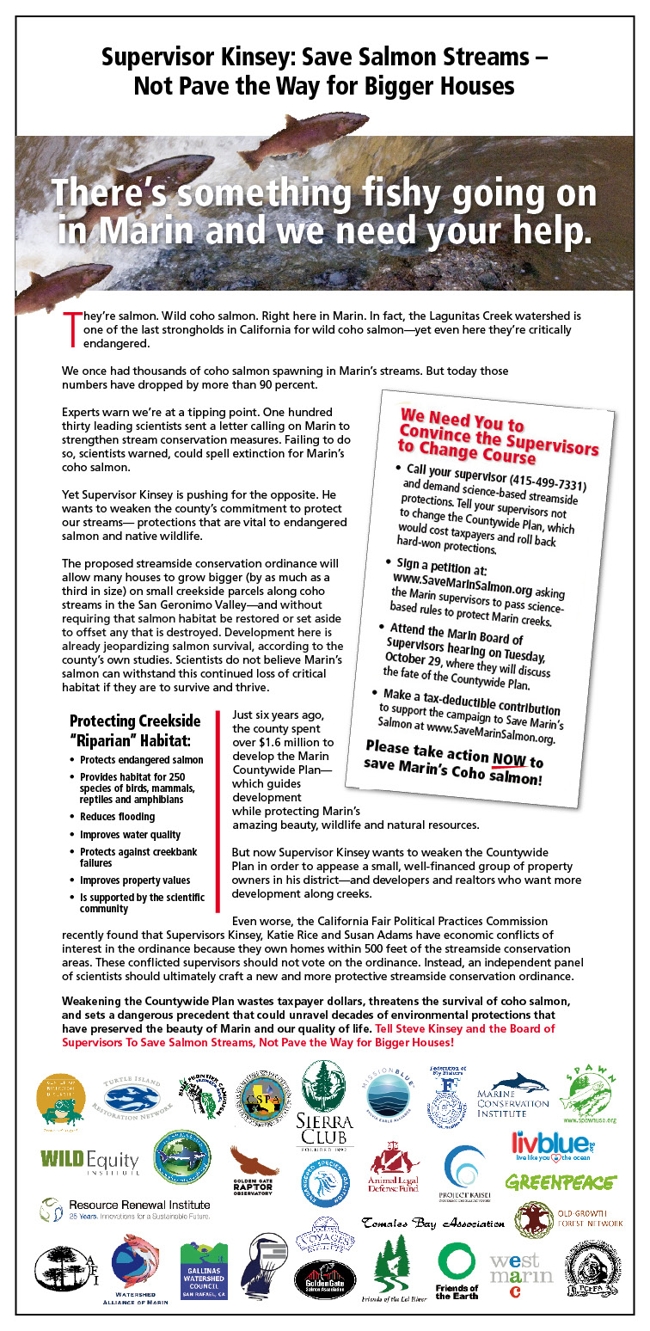
The Rose Foundation for Communities and the Environment features Wild Equity’s Brent Plater and our work protecting Antioch’s people and endangered species in the Foundation’s most recent newsletter.
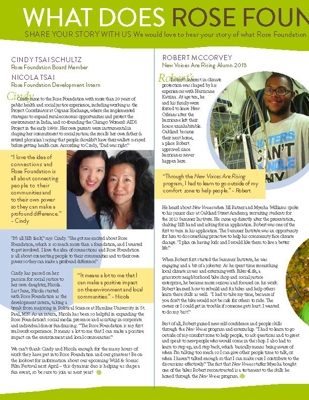
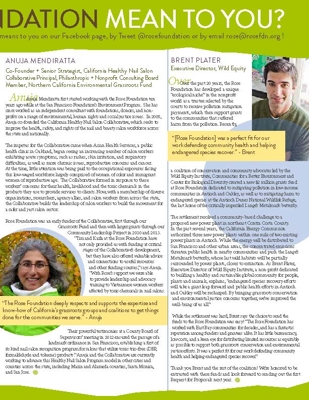
Click the image to read the full article.
Here are some excerpts from the article:
A coalition of conservation and community advocates led by the Wild Equity Institute created a new $2 million grants fund at Rose Foundation dedicated to mitigating pollution in low-income communities in Antioch and Oakley, as well as to mitigating harm to endangered species at the Antioch Dunes National Wildlife Refuge, the last home of the critically imperiled Lange’s Metalmark butterfly.
In the past several years, the California Energy Commission authorized three new power plants within one mile of two existing power plants in Antioch. While the energy will be distributed to San Francisco and other urban areas, the concentrated emissions threaten public health in nearby communities and push the Lange’s Metalmark butterfly, whose last wild habitats will be partially surrounded by power plants, closer to extinction.
As Brent Plater, Executive Director of Wild Equity Institute, a non-profit dedicated to building a healthy and sustainable global community for people, plants and animals, explains, “endangered species recovery efforts will take a giant leap forward and public health efforts in Antioch and Oakley will be recharged. By bringing grassroots conservation and environmental justice concerns together, we’ve improved the well-being of us all.”
Thank you Brent and the rest of the coalition! We’re honored to be entrusted with these funds and look forward to sending out the first Request for Proposals next year.
And we thank the Rose Foundation for supporting our work and inspiring us to create a more just and sustainable world for all!
Stay tuned for updates on the fund and additional actions we’ll be taking in Antioch to protect people and the plants and animals that accompany us on Earth.
Part-Time Project Coordinator Position
2014 Golden Gate National Parks Endangered Species Big Year
Position Summary.
Wild Equity Institute is seeking a Part-Time Project Coordinator for the 2014 Golden Gate National Parks Endangered Species Big Year competition. The Project Coordinator will be responsible for reviewing participant evaluations and project partner feedback from previous iterations of the project; revising the event structure and prize schedule for the project; and scheduling events that will implement the project throughout 2014.
The Golden Gate National Parks Endangered Species Big Year (a new project title is under discussion) is a race against time to observe each of the endangered and threatened species found within the Golden Gate National Parks, while taking discrete conservation recovery actions that will prevent these species from going extinct. It is a competitive event: the person who sees and helps the most species during the year will win the competition.
The project enables participants to explore the diverse habitats of the GGNP while helping each of the endangered and threatened species that call the Park home. In the process, we hope participants will discover the humility, compassion, and hope embodied in the legal protections for this land and our imperiled neighbors.
Major Duties and Responsibilities.
- Review feedback from previous iterations of the project. Consult with project partners and supporters to clarify feedback as needed.
- Propose structural changes to the event and prize structure of the project for 2014 for adoption by Wild Equity’s Board of Directors.
- Coordinate project logistics including field outings and other events, prizes, and some fundraising.
- Communicate with the public about the project through press releases and events, writing newsletters and social media content, and collaborating with organizing staff and volunteers.
- Track participation and evaluate project events.
Desired Qualifications.
- An undergraduate degree in Environmental Studies or related field.
- Strong knowledge of Bay Area plants and wildlife.
- Demonstrated project and/or event management experience.
- Excellent writing skills.
- Keen attention to detail.
- Ability to handle multiple tasks simultaneously while meeting deadlines.
- Exceptional interpersonal skills.
- Computer skills including Word, PowerPoint, Excel.
- Flexibility working hours, with ability to work some evenings and weekends.
This job is expected to require 20 hours per week and will be based in Wild Equity’s office in San Francisco’s Mission District. Compensation is commensurate with experience.
To apply for this position, please submit a resume, a writing sample, a list of references, and a cover letter describing your interest in our work to info@wildequity.org. The position is available immediately.

Celebrate the 2013 International Young Eco-Hero Awards!
When: Friday, October 18, 2013, 6:00 – 8:30 p.m.
Hear from six inspiring young environmental activists, winners of our International Young Eco-Hero Awards, 8- to 16-years-old, who are campaigning, conducting research, and encouraging others.
Keynote Speaker: Brent Plater, Executive Director of the Wild Equity Institute, a non-profit organization that unites grassroots conservation and environmental justice movements.
Delicious Refreshments – Silent Auction – Awe-inspiring Video
Where: American Institute of Architects, 130 Sutter Street, Suite 600, San Francisco, CA. Close to public transportation, including BART. Across from Crocker Galleria Garage on Sutter Street.
RSVP with names of attendees to mail@actionfornature.org (or call 415.922.6155 or 415.513.2421).
People of all ages welcome! If you are unable to attend, please consider making a donation to the address on this invitation or online.
Today Patagonia’s San Francisco store awarded Wild Equity $3,000 for our campaign protecting community health and endangered species near the Antioch Dunes.
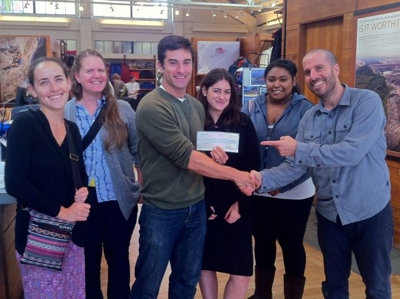
Wild Equity’s Laura Horton, Amy Zehring, Brent Plater, Sarah Fliesher, and Virginia Delgado
receive $3,000 from Patagonia’s Niko George at the San Francisco store.
This award is just the latest example of the store’s generous support of our work. In 2011 Wild Equity was awarded the store’s Voice Your Choice Award, and the store’s grants and in-kind donations have helped nearly all of our projects.
Our heartfelt thanks to the entire Patagonia SF Crew for investing in our work, for keeping us warm and dry, and for being such a big part of our vision for a more just and fair world for all.
If you are interested in supporting our work, you can contribute online using our donation page today. There are many options to choose from: you can become a member, give a gift membership, obtain matching grants from your employer, volunteer, or donate office items, all through our donation page. Just let us know how you want to be involved: and thanks for all you do!
The Wild Equity Institute works with dozens of partners, but one of our most beneficent is Patagonia’s San Francisco store. Over the past year the store gave us several grants for our work, and its customers elected us their Voice Your Choice Grand Prize winner in 2011.
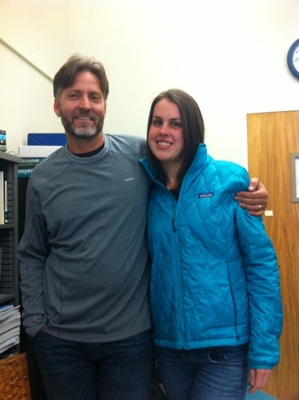
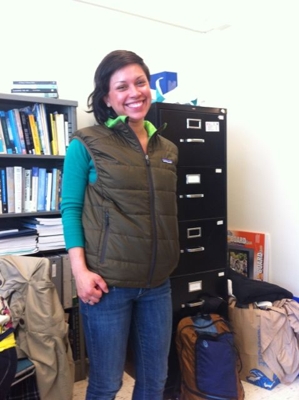
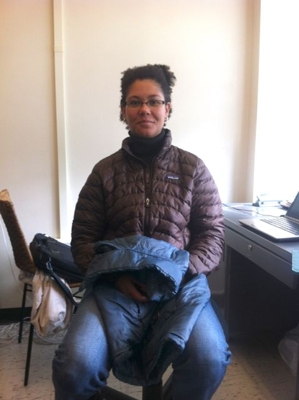
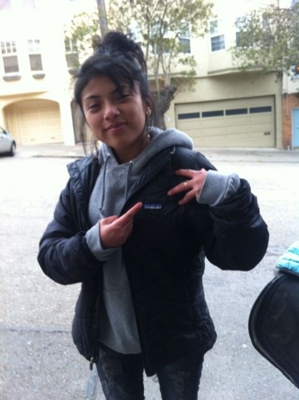
Clockwise from top left: Wild Equity Institute volunteers Mark Russell and Erica Ely used Patagonia gear to find endangered species in need of protection; Roxy Ramirez used her Patagonia gear helping us organize support for our campaigns; Zindy won a Patagonia Jacket through the Endangered Species Big Year; and Natasha Dunn helped us convince the Board of Supervisors to restore Sharp Park.
Their support has also helped our volunteers in a variety of ways. Patagonia’s product donations have helped our volunteers stay warm and dry, indoors and out, as we’ve campaigned for a healthy and sustainable world for people and the plants and animals that accompany us on Earth. We can’t thank the Patagonia store enough for all their support, but we hope these photos of our wonderful volunteers in their amazing Patagonia gear are a good start!
If you are interested in supporting our work, you can contribute online in a variety of ways. You can become a member, give a gift membership, obtain matching grants from your employer, volunteer, donate office items or other products, and even go solar with Sungevity while supporting our work. Thanks for all you do!
The face of the Presidio is changing and our input is needed. The Presidio Trust is acting on long-term plans to create a cultural space at the historic site of the former Commissary. As Sports Basement transitions elsewhere in the Presidio, the new space promises to be a cornerstone of the park going forward. We have the opportunity to see that the changes both embody and strengthen the mission of the National Park Service. The Trust is currently considering three proposals for the Presidio’s former Commissary site, now occupied by Sports Basement: the Lucas Cultural Arts Museum, the Bridge/Sustainability Institute, and the Presidio Exchange.
The Wild Equity Institute believes that the Presidio Exchange (PX) creates the greatest sense of place by focusing on the beautiful and distinctive Presidio park space, while also housing a cultural and historical center. The proposed Lucas Cultural Arts Museum simply does not embody the spirit of the Presidio or the National Park System. While the Bridge/Sustainability Institute proposal attempts to incorporate the unique setting that is the Presidio, the plans come across as interchangeable with any other sustainable business building complex.

Crissy Field Marsh and Lagoon restoration could benefit from a good design for the Commissary.
However, the Sustainability Institute proposal does contain one element that should be explored and potentially adopted by the PX proposal: expanding Crissy Field Marsh and Lagoon into the Commissary property. Due to a variety of constraints, the restoration of Crissy Field Marsh and Lagoon several years ago was limited to a smaller zone than is needed for the lagoon to fulfill its intended ecological functions. The PX proposal should review the sustainability institute’s proposal to expand the lagoon and incorporate that element into its project to the maximum extent possible.
While the PX proposal is the best fit of the three choices for this location, it tries to be too many things to too many people all at once, and in the process short-changes the unique elements of its National Park setting. The National Park Service’s Organic Act, which established the agency, includes a non-impairment mandate. This mandate requires the agency to “conserve the scenery and the natural and historic objects and wild life therein and to provide for the enjoyment of the same in such manner and by such means as will leave them unimpaired for the enjoyment of future generations.” This is the National Park Service’s unique contribution to the multitude of open space agencies in the Bay Area, yet remains a relatively unknown element of park management. We would like to see the PX live up to this mandate by making a greater commitment to interpreting and explaining the National Park Service’s unique mission.
The former Commissary site at the Presidio has the potential to be a place of magic and beauty where the story of the unique land management mandates of the GGNRA and the Presidio are widely told. The Wild Equity Institute suggests that the Presidio Exchange receive the bid, but that the proposal should be modified to ensure that the programming is fully committed to the mission of the National Park Service.
Tell the Presidio Trust that you support the Presidio Exchange with modifications. Submit your comments at http://www.presidio.gov/about/Pages/commissary-proposals.aspx today!
Mark your calendar for September 23, 2013, 6:30 pm, 385 Moraga Avenue in the Presidio. Public presentations of final Commissary proposals followed by a question and answer session.
In a new book on animals in America, Wild Ones, Jon Mooallem dedicates nearly 100 pages to the Lange’s Metalmark Butterfly. He describes the storied history and destruction of their habitat in the Antioch Dunes, no longer actual sand dunes due to extensive sand removal and industry. He also describes some of the famous lepidopterists, or butterfly scientists, who have loved the land and the Lange’s over the decades since it was first discovered by William Harry Lange in 1933.
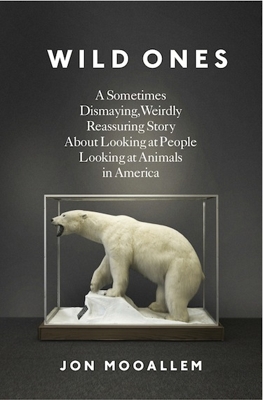
Cover of Mooallem’s new book featuring Wild Equity.
On one of his jaunts to Antioch, Mooallem found himself counting butterflies alongside our own Brent Plater. The author describes Wild Equity’s case against the proposed new power plants near the wildlife refuge, which are poised to harm the butterfly through habitat destruction due to increased nitrogen deposited on the land. He muses over a conversation he had with Brent out at the dunes, and paraphrasing Brent’s words, he states, “the balance is so out of whack that every battle is now a battle of principle that can’t be forfeited.” Mooallem portrays the goal of a settlement, which could provide a comprehensive habitat restoration for the Langes Metalmark, as “yet another freak turning point” in the “chaos” the little butterfly has had to endure but to re-establish habitat rather than continue the destruction (191).
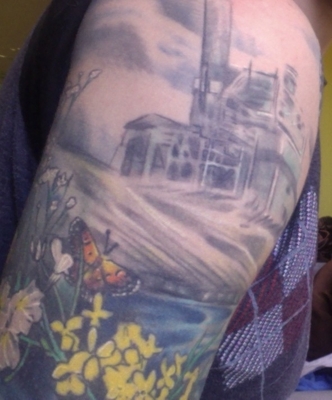
Tatzoo fellow Matt Switzer’s Lange’s Metalmark Butterfly tattoo.
Mooallem’s work extends far beyond the Langes Metalmark Butterfly. One self-taught San Franciscan butterfly enthusiast, Liam O’Brien, provides the guiding words of the book: “I just want to be part of the generation that tries” (118). Wild Equity strives to be part of that generation by using the court system to its fullest to benefit people and endangered species. We are honored to be included in Mooallem’s new work about the species we cherish most. Find out more about the book here.
In front of a packed audience last month, Wild Equity Institute Executive Director Brent Plater discussed communicating science to the public with Azibuike Akaba, an Environmental Policy Analyst at Public Health Institute, and Rose Aguilar, a journalist and radio host of Your Call on San Francisco’s KALW.
Listen to the audio archive of the entire presentation.
Azibuike discussed the framing and language of scientists and engineers. He defined resilience as a community that takes care of each other, and suggested focussing on the experience in nature. He claimed it’s not true that scientists define our experience of nature, although we often allow them to. He reminded the group that science is funded by someone who is class-interest based, and suggested scrutinizing scientific claims to ensure that science isn’t wielded simply to perpetuate existing biases.
After Azibuike spoke, Brent invoked the meme of the Anthropocene, a term that suggests humans are now as impactful on the earth as a glacial period or asteroid strike—catastrophic events that have been used to define biologic and geologic time. He critiqued Peter Kareiva, the Chief Scientist for The Nature Conservancy, who suggests our massive impacts on Earth means the environmental movement is a failure, and should be transformed into a industry-friendly movement. Brent criticized Kareiva not for his suggestion that the environmental movement needs work, but because Kareiva suggests we should cede our demands to the movement’s opponents. Instead, Brent argued we should tell the public about our beliefs, which are widely shared, and not just what we know.
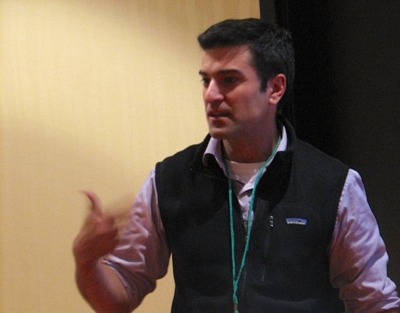
Brent sharing his views about science and ecology.
Brent analogized to the Lord of the Rings series to demonstrate this difference. He argued that the fable teaches us two ways to change the world. The first is with the “magic ring” of scientific expertise. This specialized knowledge has been the main strategy of change used by the modern environmental movement. The second way to change the world is raise an army of orcs: Brent declared that it’s time to catalyze the public by using language that demonstrates our heartfelt values, not only language that describes science. He hearkened back to the mass movements of the 1970s. Brent ended by asking, “What is it you believe? Was it some moral foundation that lead you to this work?” He claimed we need to figure out ways to give expression to these reasons in a time of scientific dependence.
Rose Aguilar then took the microphone to discuss the media’s relationship to science. Independent outlets are overwhelmed by corporate conglomerates, and entertainment and crime dominate over environmental issues. She noted many of the major news outlets are dismantling their environmental desks and reassigning environmental reporters. She noted that we now have to work harder and go the extra mile to find information about our world. Rose questioned why we place the burden of responsibility on individuals rather than corporations and called for broad social change.
The audience brought important questions and issues to the panel, and the evening incited conversation throughout the crowd. Azibuike, Brent, and Rose brought diverse viewpoints and opinions to this extensive topic.

Join a challenging conversation some have dubbed “environmental communications in the Anthropocene” to discuss the problems with presenting complex ecological information publicly. Rose Aguilar from KALW’s Your Call radio, Brent Plater of the Wild Equity Institute, and environmental scientist and climate change activist Azibuike Akaba discuss and debate issues of scientific literacy, critical thinking, basic education, attention spans, buzzwords, guest selection, framing and definition of scientific issues, overcoming simplistic jargon, and much more!
Hosted by Shaping San Francisco, the show starts at 7:30 p.m. at the Eric Quezada Center for Culture and Politics, 518 Valencia St. (near 16th St.) in San Francisco.
In late October of 2012, Wild Equity Institute Executive Director Brent Plater was invited to a weekend workshop to discuss the future of the conservation movement with luminaries in several environmental fields. The following essay is one of several products we’ve produced based on that workshop.
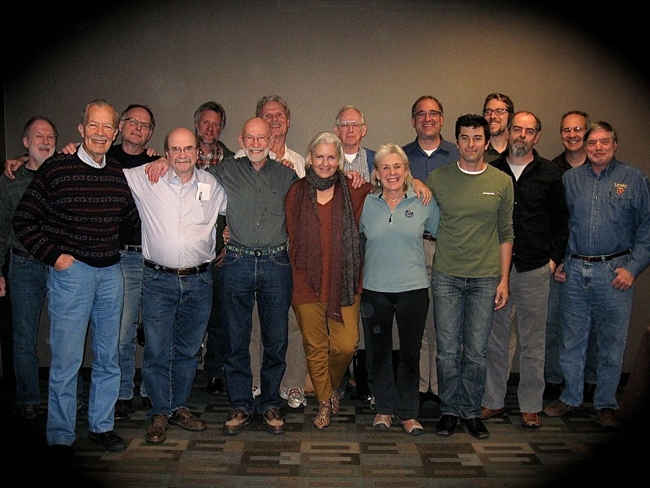
Back row, L-R: Michael Kellett, Brooke Williams, Michael Matz, George Wuerthner, Holmes Rolston, III, Phil Cafaro, Noah Greenwald, Dominick DellaSala. Front row, L-R: John Terborgh, David Johns, Michael Soule, Terry Tempest Williams, Ronni Egan, Brent Plater, Kieran Suckling, Brock Evans. Not pictured: Don Weeden, Helen Robertson, Charmayne Palomba, Eileen Crist, Andy Kerr, Tom Butler, Dan Doak, Jordan Fisher Smith, Gary Tabor.
In a recent issue of Around the Campfire, Dave Foreman—a co-founder of Earth First! & the Wildlands Project and author of Confessions of an Eco-Warrior—wrote a provocative essay titled The Myth of the Environmental Movement. In it he suggests that the conservation movement and the environmental movement are two distinct—and very different—movements.
The Wild Equity Institute believes Dave’s article is on to something—it’s true that our use of the words ‘conservation’ and ‘environment’ has become sloppy, and they can often mean conflicting things to different people.
But what creates fissures within the broader conservation/environmental movement isn’t found in the movements’ focuses—which Dave suggests are wildlife on the one hand, people on the other—but in their reason and rationale for existing: their ethical foundation.
The Wild Equity Institute illustrates this point concretely. We believe that stopping extinction is a moral imperative-–not because it is good for people, but because it is wrong to cause species to go extinct when extinction rates are exceptional. And today extinction rates are exceptional—orders of magnitude larger than the background rate of extinction. However, for others preventing extinction may be a utilitarian exercise: they may believe it is wrong to let species go extinct because this or that species may have some human use.
A utilitarian conservationist is likely to conflict with an ethical conservationist in many cases. For example, if a particular species has no demonstrable value to people or the ecosystem services upon which we depend, a utilitarian point of view might suggest we should allow the species to go extinct, even as the ethical conservationist argues the opposite point. Yet because the object of concern—other forms of life—is one and the same for both the ethical and utilitarian person, it seems logical, at first blush, to consider both to be part of the same movement. Indeed, the Endangered Species Act’s legislative history reflects both moral and utilitarian reasons for conserving wildlife and plants.
The same division exists within the environmentalists/conservationists that focus on human well-being. Some people advocate for improved quality of life because they believe it is wrong to cause harm to other people by polluting for profit. The environmental justice movement is the most obvious example of this ethical concern, but nearly any other segment of the environmental movement can be described as trying to protect those without political power (consumers, kids, etc.) from those with it (agribusiness, petrochemical companies, etc.). But there are also people who are involved in human health movements simply because they want to breathe clean air, or drink safe water, or ensure that they have a safe place to recreate. This is a very different—largely utilitarian—rationale for the same environmental concern.
What ultimately creates a fissure in the environmental/conservation movements is not the object of our concerns, but the reason for our concerns in the first place. If you are a conservationist by moral imperative, you will probably have more in common with those who are environmentalists by moral imperative than you would with a utilitarian conservationist. Similarly, the utilitarian conservationist and the utilitarian environmentalist are likely to have a lot in common with each other, and little in common with ethical environmentalists/conservationists.
We believe our own mission helps demonstrate how this is so. The Wild Equity Institute believes that the shared moral foundation in our movements is equity: the creation of a more just and fair world. Our equity-based concerns are easily seen in the environmental justice movement’s focus on the inequitable distribution of environmental hazards—and increasingly, its focus on the inequitable access provided to environmental goods like open space and parks. But the grassroots conservation movement also works to remedy an inequitable relationship: between our human communities and the non-human world. As we consume a greater share of the world’s finite resources, less remains for the plants and animals around us, driving thousands of species to the brink of extinction. While the moral consideration we owe to each other may be different in kind and scope to what we owe to other forms of life, in both cases the gap between what our moral foundation suggests we should do and how we actually act leaves us with a culturally isolated and biologically impoverished world.
The Wild Equity Institute’s purpose is to unite these movements into a powerful force that creates a healthy and sustainable global community for all. We accomplish this by working on projects that highlight and redress the inequitable relationships across our human communities while improving our relationship to the lands in which we live. In that sense, those who focus on equity-–inter-species equity on the one hand, and intra-species equity on the other-–are really part of single movement, regardless of whether their day-to-day work is focused on NOx emissions or invasive plants (and even those are interlinked, science now tells us).
In that sense, Dave Forman, who is one of country’s greatest ethical conservationists, has more in common with the late Luke Cole (the founder of the Center on Race, Poverty, & the Environment) than he does with Peter Kareiva (the Chief Scientist at the Nature Conservancy) who is currently attempting to obliterate conservation as we know it based on utilitarian arguments. Dave Forman and Peter Kareiva cannot be reconciled into one movement: even though both ostensibly are attempting to conserve wildlife. But Dave and Luke, on the other hand, could be reconciled into one movement—even though Forman focuses on wildlife and Cole on human-life—because at base they have the same moral foundation.
The dichotomy between wildlife-people and people-people is unhelpful both because it prevents us from engaging allies and building power, and because it adds confusion to an area of our work that desperately needs clarity. It needs clarity because if we don’t know how and why we stand together, our efforts to address the systemic, cross-cutting threats facing people and the planet will likely be disjointed, slow, and rupture alliances. By drawing on our moral imperative, rather than the object upon which our movement is focused, the Wild Equity Institute believes we can avoid this outcome. Because our ethical foundation is where our commonality can be demonstrated most clearly, and from there we can build a more powerful movement for people and the plants and animals that accompany us on Earth.
California members and supporters,
I’m writing to let you know about a unique clean energy investment opportunity we recently learned about. Mosaic is an online platform that enables individuals to invest in solar projects being developed across the country. Warren Buffett has invested $4 billion in solar energy and now, with a minimum investment of $25, you too can do well by doing good. Click here to begin investing in a clean energy future.

The Mosaic funding model aggregates our individual investments into complete solar projects.
Here’s how it works: You invest in high quality solar projects through Mosaic’s website. The solar project developers earn revenue by selling the electricity they produce. This revenue enables Mosaic to pay you back with interest.*
Mosaic is fundamentally changing the way clean energy is financed, no big banks or big bank accounts required. The more you invest, the more solar power gets generated and the greater your potential return. It’s a win-win for you and the planet. Bank on the sun with Mosaic and earn competitive returns.
We here at the Wild Equity Institute share Mosaic’s mission of democratizing clean energy and encourage you to check out Mosaic today.
Sincerely, Brent Plater Executive Director |
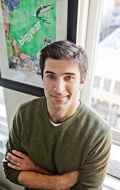 |
P.S.—Watch this short video about Mosaic produced by our friends at Green for All.
- Please visit joinmosaic.com to learn more about the project and to access the offering memorandum, which discusses the project, the terms of the investment and the risks associated with this investment.
We’re excited to announce that Laura Horton, a long-time volunteer and law clerk, has joined Wild Equity as a Staff Attorney. She will be working with Executive Director Brent Plater and our amazing volunteers to help us unite grassroots conservation and justice movements to create a more equitable and sustainable world for all.
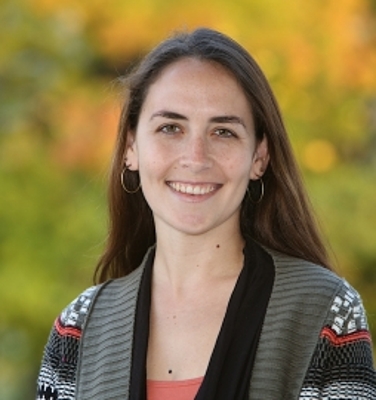
Laura Horton, Wild Equity Institute Staff Attorney.
Laura has been passionate about environmental issues for as long as she can remember. Over the years she has worked for various environmental organizations, including a legal internship at Wild Equity, and has been active in social justice issues. During law school Laura was a student leader in the National Lawyers Guild and the ACLU, and was the Managing Editor of the Environmental Law Journal. She has published articles on a number of issues including energy, immigration and disaster law, and eco-consumerism, and also currently serves as a volunteer writer/editor for both the National Lawyers Guild Review and the American Society of Legal Scholars.
Prior to joining Wild Equity, Laura received a fellowship to work with the Zimbabwe Environmental Law Association in Harare, Zimbabwe, where she helped empower rural mining communities in asserting their environmental and economic rights. Laura holds a B.A. in Philosophy from the University of North Carolina at Wilmington and a J.D. from Golden Gate Law. She says she is beyond thrilled to return to Wild Equity as a staff attorney, and we’re honored to have her on board as well. Welcome Laura!
Sunday, March 24, 11:00 am – 1:00 pm: Join Brent Plater of the Wild Equity Institute to search for two of the most imperiled vertebrate species on the San Francisco peninsula: the California red-legged frog and the San Francisco garter snake.
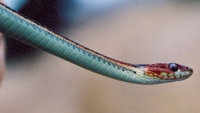
This will be a leisurely walk to enjoy the restoration work being conducted at Mori Point and to learn about the bold steps being taken to save the frogs and the snakes from the brink of extinction.
Meet at the Mori Point Entrance Gate, at the intersection of Bradford Way and Mori Point Road, Pacifica, CA, 94044.
Please RSVP here. NOTE: you must have a free wildequity.org account to RSVP for events. Sign-up here if you need an account.
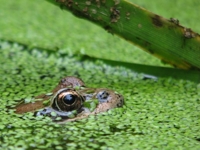
Brent Plater, Wild Equity’s Executive Director, will be interviewed on KOWS 107.3 FM’s Tommy’s Holiday Camp about Wild Equity’s work protecting people and the plants and animals within and surrounding the Antioch Dunes National Wildlife Refuge. Listen in from 7:10-8:55pm to learn what nitrogen deposition can teach us about the future of conservation.
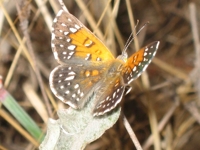
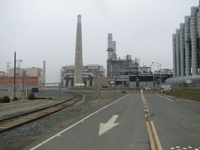
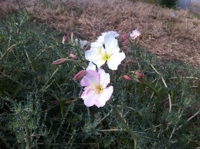
Click here to listen to the podcast of the interview.
In a reality grantmaking panel with $1,000 on the line, program officers from the Hewlett Foundation, the San Francisco Foundation, the California Wildlands Grassroots Fund, the Northern California Environmental Grassroots Fund, and the Rose Foundation for Communities and the Environment evaluated grant proposals from Wild Equity and five other groups live in front of over 100 grassroots environmentalists.
And each program officer reached the same conclusion: Wild Equity’s proposal was the best of the bunch!
Check out this clip from the panel and see why so many are finding inspiration in our work:
We were humbled to earn the $1,000 from the panel, and grateful for the constructive feedback we received from these experienced grantmakers. Consider following their advice—help us become more effective by contributing to the Wild Equity Institute’s work today!
Wild Equity Institute is receiving its first branded products soon, and the buzz is building. For example, a focus group participant at San Francisco State University had this to say about our new “I Bird San Francisco” T-shirt:
“This shirt has value far more important than its price. How much is it worth to promote environmental protection in your community? How much is it worth to use organic clothes? The shirt is worth our entire future as a civilization.”
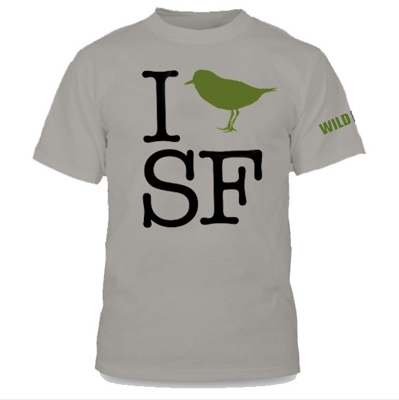
I Bird SF 100% organic cotton T-shirt. Comes in natural color, sizes S, M, L, & XL.
That’s right folks: our I Bird SF shirt is worth our entire future as a civilization!
Lucky for you we’re giving them away—to members who contribute $60 or more to our end of year membership drive! Either join Wild Equity or renew your membership at the $60 level or more and you’ll get an I Bird SF T-shirt on the house!
Already have plenty of shirts? No problem! You can substitute a Wild Equity branded reusable water bottle made in the USA from 100% recycled aluminum!

The Wild Equity bottle is made of 100% recycled aluminum in the USA.
24oz with twist-off cap. Select green or white.
Want the bottle and the shirt? We’ve got a solution for you too: if you contribute at the $100 level or more, we’ll send you one T-shirt and one water bottle at no extra charge!
Ladies and gentlemen, there hasn’t been a Wild Equity membership deal this good since….well ever! Not only do you get some cool sustainable products, you also get to contribute to our work saving San Francisco’s Natural Areas Program so it can continue stewarding our local plants and wildlife; transforming Sharp Park Golf Course into a new national park everyone can enjoy; and saving the Lange’s Metalmark Butterfly and empowering local communities to end pollution from power plants that destroy the species’ habitat.
So join now and let the world see that you’re part of our movement. Of course, you can always decline the stuff and let all of your contribution go directly to our work: just let us know what you prefer in the notes section of your order! Be sure to specify color for the bottle, and size for the shirt! And thank you for believing in our work!
Sincerely, Brent Plater Executive Director |
 |
ps—If you already gave this year and earned a shirt and/or a bottle, we’ve got you covered! We’ll contact you when they are ready to ship and take your order. Or contact us anytime and let us know what you want! We expect first shipments to go out in late January.
I’m starting this note with two short stories that inspired our work this year. After reading them, I believe you’ll be inspired to become a Wild Equity Institute member, so we can continue our extraordinary work.
Recently I returned from a weekend workshop where I discussed the future of the conservation movement with giants in our field—people like Dr. Michael Soulé, the founder of the field of conservation biology; Dr. Holmes Ralston III, a luminary in the field of environmental ethics; and Terry Tempest Williams, one of our great contemporary environmental writers.
It was an honor to simply be in a room with these incredible people. But as the meeting progressed, I was humbled to see that they found inspiration in the Wild Equity Institute’s work, and are incorporating our theory of change into a new era of environmental protection and conservation.
Around the same time I received this note from a student who participated in Wild Equity’s Endangered Species Big Semester, our environmental education project that helps disadvantaged students see and save our local endangered species:
“I got a lot from your program, like great memories and the chance to meet amazing people. I’m so thankful Wild Equity made it possible to help me learn, not only was it educational, but also it was fun and exciting. I absolutely loved all the field trips and would enjoy doing it again.”
We are proud that in just three short years we’ve improved lives and inspired leaders to build a stronger environmental movement for all.
But we can’t do it alone: and that’s why we’re asking you to become a Wild Equity Institute member today.
The Wild Equity Institute believes we can achieve extraordinary environmental victories while building a larger, more resilient environmental movement. We do this by uniting grassroots conservation and environmental justice groups in campaigns that build a more equitable world for people and the plants and animals that accompany us on Earth.
At a minimum, this means our work must focus on preventing other species from going extinct, and ensuring that no community is burdened with a disproportionate share of environmentally harmful activities.
In 2012, we implemented this theory of change in several ways:
- We filed a formal administrative petition, dubbed the Pale Male Petition, to protect bird nests from wanton destruction.
- We won endangered species protection for the Franciscan Manzanita, which included the first critical habitat proposal ever for San Francisco’s urban parks.
- We advanced a lawsuit to protect the Antioch Dunes National Wildlife Refuge and surrounding communities from five gas-fired power plants that will pollute the air we breathe and contaminate the soil of three endangered species.
- We hosted a tailgate at Sharp Park to protest the golf course’s killing of endangered species, caught Assembly member Jerry Hill and San Mateo County Supervisor Carole Groom presenting forged assembly resolutions on Sharp Park, and won significant interim rulings in our lawsuit against the golf course.
- We strengthened the structure of our organization by adding two new members to our Board of Directors and earning new grants from several new foundations.
But we aren’t done yet. In 2013, we will work to save San Francisco’s Natural Areas Program so it can continue stewarding our local plants and wildlife; transform Sharp Park Golf Course into a new national park everyone can enjoy; and save the Lange’s Metalmark Butterfly and empower local communities to end pollution from power plants that destroy the species’ habitat.
In each of these efforts, we build capacity for our movement by engaging new allies and building the power we need to tackle our most pressing environmental problems.
That’s why when you contribute to our work you get a twofer: we achieve measurable environmental gains on the ground, but more importantly, we ensure that our movement grows so that the scale of our efforts can match the size of the threats we face.
But movements are not defined by the effectiveness of organizations. They are defined by the inspiration, the passion, the commitment of the people these organizations serve. This is why we need you to demonstrate your commitment by becoming a Wild Equity member today.
Imagine the world we will build together: a more equitable world for people and the plants and animals that accompany us on Earth. Thank you for supporting this vision and for joining us today!
 Sincerely,
Sincerely,
Brent Plater
Executive Director
P.S.— Consider becoming a monthly donor. For as little as $5 a month, you’ll help us spend less time raising funds and more time wining campaigns for people and the plants and animals that accompany us on Earth! You can do this online at the Wild Equity Institute’s website. Thank you!
Sunday, December 2, 2012, 11:00 am – 1:30 pm – Join us for the last epic GGNP Big Year hike of the year! Brent Plater will lead the hike out to Muir Woods to see and save the threatened Coho Salmon, Central California Coast ESU, and the Steelhead, Central California Coast DPS. Witness the semelparous spawning behavior of the Coho Salmon and take an action to help save these imperiled species. Everyone pays their own $7 entrance into the park. Please RSVP now!
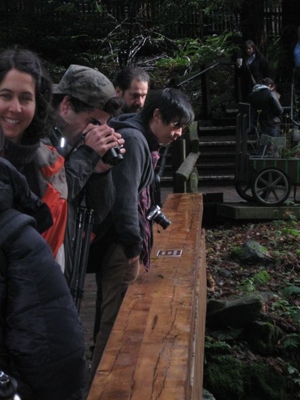
Searching for spawning Coho Salmon.
During the month of November, participants in Wild Equity’s GGNP Endangered Species Big Year can win a $25 gift certificate to the Sports Basement: if they are the first person who records a sighting for, and/or takes action to help, the Western Snowy Plover.
We’ve lead a trip or two to see this cute little puff of feathers within the GGNRA, but now it’s time for participants to conduct the Conservation Action Item for this bird: reduce harassment of the Snowy Plover by leashing your dog in plover areas and/or asking others to do the same.
Off leash dogs are the biggest recreational threat to the Western Snowy Plover at the Golden Gate National Parks. Not because dogs are mean, but because unleashed dogs are much more effective at chasing and disturbing this tiny shorebird than anyone or thing you can find on San Francisco’s beaches. Help this endangered species by leashing your dog in sensitive Snowy Plover habitats and asking other people to do the same.
To claim your prize be sure to sign-up for the GGNP Endangered Species Big Year and record your action items and sightings at our website. If you don’t record it, it didn’t happen, and it doesn’t count!
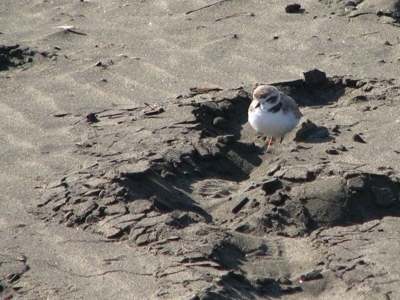
Folks, we have some great prizes to give away during the remaining months of the GGNP Endangered Species Big Year!
In November we are giving one lucky winner a $25 gift certificate to Sports Basement.
Here are the details:
The first person to record a sighting for the Western Snowy Plover and fulfill the conservation action item will be awarded a gift certificate to Sports Basement.
The Conservation Action Item: Reduce harassment for the Snowy Plover by leashing your dog in plover areas and asking others to do the same.
Unleashed dogs are the biggest threat to the Western Snowy Plover; unleashed dogs tend to chase and disturb this tiny shorebird when they are roosting at the GGNRA’s beaches. Help us protect this endangered species by leashing your dog in sensitive Snowy Plover habitats and asking other people to do that same.
Want to see the Western Snowy Plover in its natural habitat?
Join us on Sunday, November 11, from 11:00 am – 1:00 pm, at Ocean Beach for the Western Snowy Plover Walk-About, led by Plover docent David Schmidt, to search for and help the threatened Western Snowy Plover. Meet at Beach Chalet Restaurant Parking lot. RSVP now.
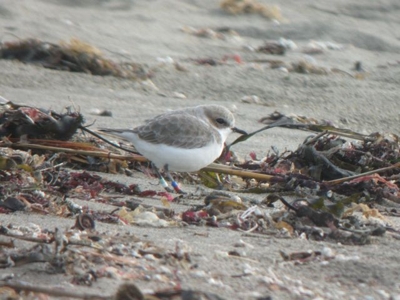
In December we are giving away a sling bag from Patagonia to the first person who a) completes the conservation action item for the Gowen Cypress, or b) records a sighting and/or action item for the Coho Salmon.

The Gowen Cypress
You will have an opportunity to see the Coho Salmon in December!
Join us on Sunday, December 2, from 11:00 am – 1:30 pm, for the Muir Woods Big Year Salmon Stroll. Meet at Muir Woods National Monument. For more information, and to RSVP, please visit the Big Year calendar.

Searching for spawing salmon.
Join the GGNP Endangered Species Big Year now and start taking action!
You don’t want to miss this coming Third Thursday Film Night with SF Environment! We will be showing the moving documentary, Pale Male, the story of a notorious red-tailed hawk who made his home above a 5th Avenue apartment building in New York City. A sensational movement transpired when the building’s co-op board ordered Pale Male’s nest to be removed.
The Pale Male Petition:
On July 24, 2012, the Wild Equity Institute filed a petition with the U.S. Fish and Wildlife Service (“Service”) urging it to change its migratory bird nest policy. The policy encourages destruction of migratory bird nests, which is prohibited by the Migratory Bird Treaty Act (MTBA). The Service’s policy has led to the destruction of countless bird nests since it was enacted, including one of a famous New York red-tailed hawk.
Please Join us at SF Environment, 11 Grove St., San Francisco, CA. There will be snacks and drinks. RSVP now!
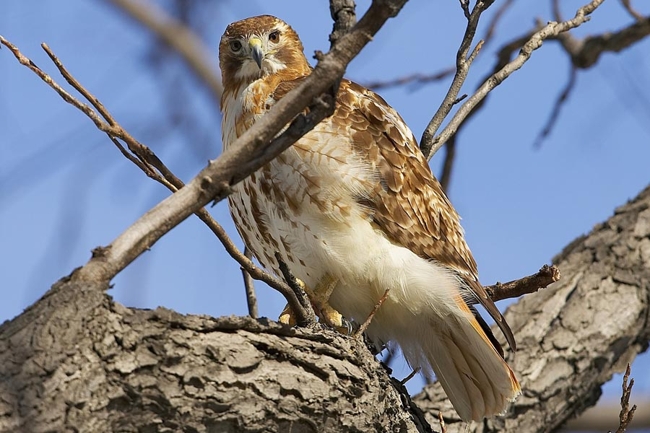
Pale Male
Thank you to all who came out this weekend to search for, and help, one of the smallest and rarest shorebirds in San Francisco, the Western Snowy Plover. On Sunday, a group of birders and plover-lovers journeyed out to sunny Ocean Beach for a hike, led by David Schmidt, to find this tiny bird in its natural and protected habitat.
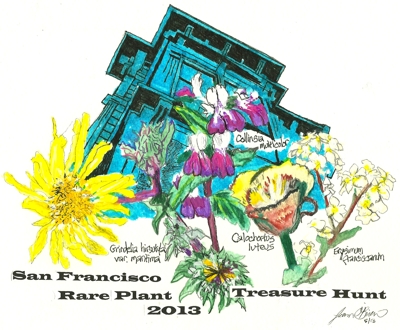
David Schmidt discussing the history of the area.
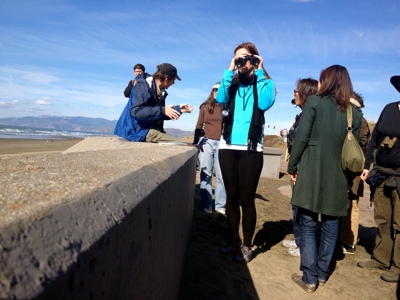
It was a beautiful day and a perfect time to find the Western Snowy Plover basking in the sun, but they must have been content hiding among the sand dunes, because we did not spot any plovers this day. However, we were lucky enough to see several Sanderlings, another small wader which, from afar, can easily be mistaken for the Snowy Plover.
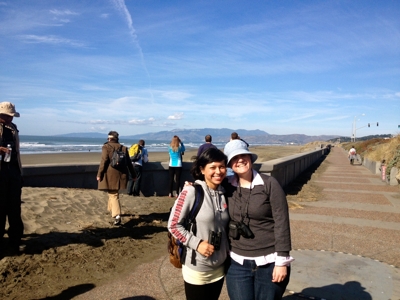

Searching for the plover and other wildlife.
We had a great time identifying other birds, socializing with friends, and learning about the history of San Francisco’s natural areas. Thanks again to everyone who joined us on this beautiful day!
Keep in mind, we are offering a gift certificate to Sports Basement for the first person who spots and/or takes action to help the Western Snowy Plover. Just be sure to sign-up for the GGNP Endangered Species Big Year to record your sightings and actions.
The Conservation Action Item: Reduce Harassment for the Snowy Plover by leashing your dog in plover areas and asking others to do the same.
It is determined that unleashed dogs are the biggest threat to the Western Snowy Plover; unleashed dogs tend to chase and disturb this tiny shorebird when they are roosting at the GGNRA’s beaches. Help us protect this endangered species by leashing your dog in sensitive Snowy Plover habitats and asking other people to do that same.
Check out the Endangered Species Big Year calendar now to RSVP for future Wild Equity events!
This weekend we will be heading out for a leisurely walk, led by David Schmidt, to see the endangered Western Snowy Plover at Ocean Beach. This small shorebird is highly threatened by off-leash dog disturbance and habitat degradation: but you can help it recover. Join us to see this adorable species in its largest remaining refuge in San Francisco, and learn how you can help before it is too late! Meet at Beach Chalet Restaurant parking lot. Please RSVP here.

On Friday, students from Downtown High School joined Wild Equity for a trip to Rodeo Lagoon to see and take action to save the endangered Tidewater Goby. This small aquatic species is listed under the endangered species act because of a significant declined in its population, mainly due to habitat destruction and invasive species. The fish is found in only a small portion of its native habitat; it is unfortunately no longer found in San Francisco.
The students learned about the Tidewater Goby’s fragile state and took action to help protect the species. Darren Fong, Aquatic Ecologist for The Golden Gate National Recreation Area, gave a talk about the history of Rodeo Lagoon and showed the students the Tidewater Goby with a special underwater camera.
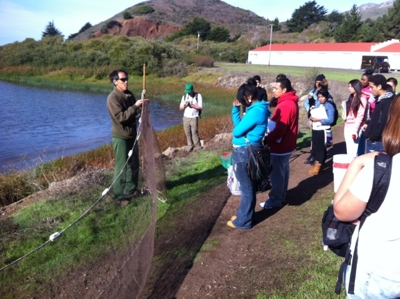
Darren Fong showing students a seine that will collect fish samples.
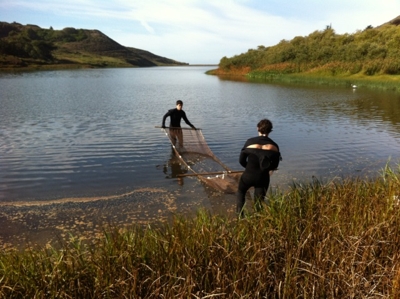
Researchers collecting samples with a seine in Rodeo Lagoon.
The students even had a chance to be field biologists for the day! Karen Crow, Assistant Professor at San Francisco State University, who studies the Three-spined stickleback for its evolutionary and genetic traits, taught the students useful sampling techniques. The Three-spine stickleback were collected from the lagoon with seines and transported into buckets where the students measured them to determine which ones would be valuable for further research.
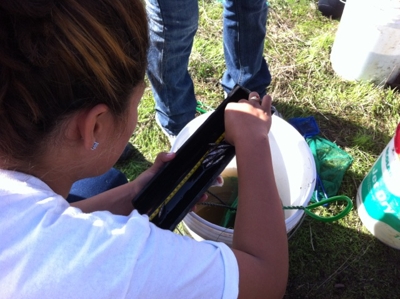
Students measuring the Three-spined stickleback.
The students were also presented with the opportunity to engage in critical habitat restoration. They worked with James Cartan, from the National Park Service, removing invasive ice plant along the lagoon shoreline.
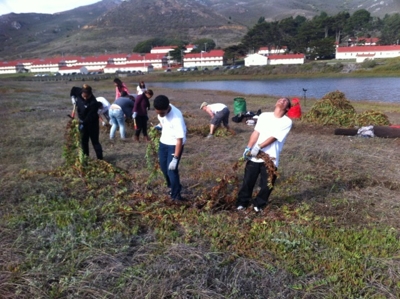
Students removing invasive ice plants.
We all had a wonderful time with the students on this trip. It was a great opportunity to learn about the ecology of Rodeo Lagoon, habitat restoration, and receive hands-on experience, which helped create a positive difference for the sensitive species at Rodeo Lagoon.

The Tidewater Goby
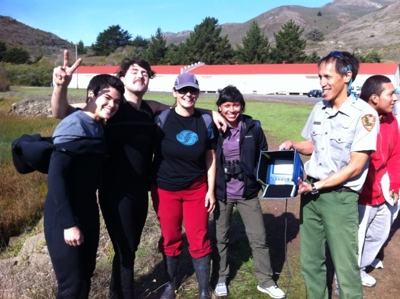
Field biologists, and Darren Fong, with the underwater camera.
You can also help create sustainable communities and protect native species by volunteering with us, becoming a member, or donating on-line today!
The Wild Equity Institute is glad to announce that Anna Sylvester has joined our Board of Directors, serving as our newest Board Secretary.
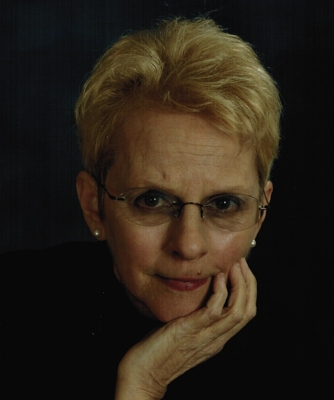
Anna Sylvester, Board Secretary.
Anna traces her love of nature to her Swiss heritage. She is focused on “legacy living”, working to preserve species, habitats, and precious coastal areas (like Sharp Park) for generations to come.
Anna and her husband, Erich Sylvester, live in the Presidio and operate Sylvester Valuation Group, a business appraisal firm specializing in fair market value appraisals for estate and gift tax purposes.
Anna previously served as secretary for another non-profit, and that experience will be put to great use on the Wild Equity Institute’s Board of Directors.
Welcome Anna! We look forward to working with you as we build a healthy and sustainable global community for all!
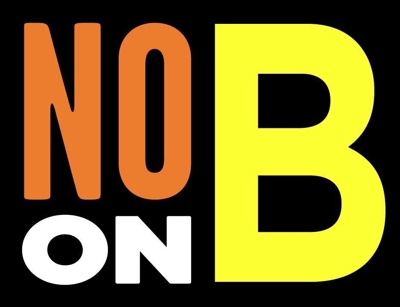
With the campaign mailer deluge hitting our mailboxes, it appears that the supporters of San Francisco’s Proposition B are spending almost as much money trying to pass the proposition as the City might generate with the bonds Prop B. authorizes!
To cut through the clutter, the Wild Equity Institute provided some initial reasons to vote no on Prop. B several days ago, but the latest mailers sparked some additional research: and confirmed our suggestion that you vote no on Prop. B.
- Capital projects will make RPD’s funding problems worse, not better. All recent analyses regarding the Recreation and Park Department’s (“RPD”) ongoing budget problems have reached the same conclusion: RPD already has more capital than it can operate and maintain. For example, the San Francisco Planning and Urban Research Association (SPUR) recently wrote:
There is a pronounced difference between funding capital improvements and funding ongoing operations. Operations have simply not been a funding priority of our elected officials, and as a result RPD has been driven to pursue additional funding in the form of concessions and services. . . . It does not makes sense to spend money improving buildings or restoring parks if we can’t afford to open those buildings or operate those parks. There needs to be a sustained commitment to operations to support any capital program. . . . In fact, our hope has been that the operating deficit would be addressed first.
Prop. B makes this problem worse: it forces San Francisco to build new capital projects without providing any stream of income to maintain the projects over time. Like all bonds, Prop. B can only fund capital projects—not a dime of the money Prop. B raises can be used to address the existing operating and maintenance backlog. Let alone the additional operations and maintenance burdens that new capital projects will impose on our park budgets.
To truly solve our parks’ budget problem, RPD needs to join with park advocacy groups demanding larger operation and management budgets at the Board of Supervisors and the Mayor’s office, where we can obtain the annual operating and maintenance money our parks need. But to date, RPD has refused to join with us, and instead it has pursued bloated capital funding, and wasted operating budgets subsidizing suburban golf in San Mateo County. Perhaps, as the SPUR report suggests, this is because RPD has failed to properly prioritize its revenue problems.
- As RPD’s maintenance and operating budget becomes more dire, the City’s Natural Areas Program suffers the most. The Natural Areas Program is not a priority within RPD, and it is funded last nearly every time budgets are reduced. If we build more capital than we can afford to maintain, the City’s operations and maintenance budgets will become even more stressed. As budgets become more constrained, staff will be cut, and it is most likely that Natural Areas Program staff will bear the brunt of those cuts. Again, Proposition B makes this problem worse by providing no funding for operations and maintenance while building several new projects RPD will be required to operate and maintain indefinitely.
- All the projects specified in the bond have been declared categorically exempt from CEQA. The Bond language incorporates categorical exemptions from CEQA for nearly all the identified projects specified in the bond. This is an abuse of CEQA, and something environmentalists and conservationists should not support.
- Building our way out of repair and maintenance is extremely environmentally harmful. RPD has suggested that Prop. B will address its maintenance backlog by getting rid of items that need repair, and building new projects in their stead. But we can think of no more environmentally harmful way to address our maintenance backlog. Is our decline into a throw-away culture so complete that even our infrastructure is now disposable? We think that in the City where single-use plastic bags have been banned, we can do better than creating throw-away capital projects. San Francisco demands better than this, and our environment requires it.
- Strategy. There is little doubt that San Francisco politicians generally, and Recreation and Park officials specifically, give little heed to conservation concerns. This is in no small measure because the conservation community needs to become more effective applying political pressure in most campaigns—Wild Equity’s campaign to restore Sharp Park being one of the few exceptions, which was the only land-use issue to get a majority vote at the Board of Supervisors in several years. To turn this around, we need to express political displeasure to those who make decisions antithetical to our concerns. This was done by opposing bond initiatives on environmental grounds in the East Bay a few years ago, and since that time East Bay parks have had a much stronger relationship with the Sierra Club. We can do the same here.
We can understand why some institutions might determine that the short-term benefits of specific, promised projects outweigh the long-term negative impacts that Prop. B imposes on our parks. Surprisingly, SPUR endorsed this proposal, albeit with an important caveat: that the long-term funding problem be addressed sooner rather than later. But Wild Equity is in it for the long-haul, and Proposition B will fundamentally make park financing more difficult if it passes.
That’s why we urge you all to vote NO on Prop. B.

Emerging Wildlife Conservation Leaders, an initiative aimed at mentoring and training up-and-coming leaders in conservation, is now looking for exceptional conservationists with over 3 years previous commitment to the environment, and at least 15 more years ahead of them in the field, is now accepting applications for its 2013 class.
Successful applicants will be offered a one-week training course in the spring of 2013 that provides networking and career mentoring opportunities, leadership and wildlife conservation campaign skills, and experience planning, implementing and evaluating a real wildlife conservation campaign benefiting an imperiled species. Follow-up meeting will occur later in 2013 and 2014.
All costs are covered for US-based participants. Applicants based outside the US must show an ability to cover the costs of flights to all three trainings, and must be fluent in English.
Applicants must download and submit the application by close-of-business November 16th, 2013. (Applicants based outside the United States will only be considered with an identified sponsor for travel costs). For more information, please go to www.WildlifeLeaders.org.
This weekend was one of the busiest in San Francisco history. In addition to all the festivities throughout the city, the Franciscan Manzanita was officially listed under the Endangered Species Act along with a proposal for several acres of critical habitat and, of course, we threw one big party to celebrate.
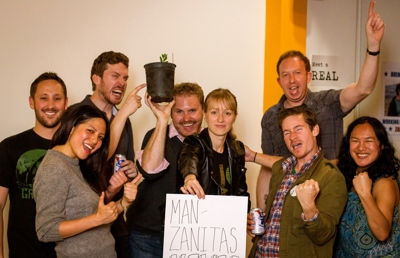
© David Burban
Thank you to all who came out on Friday to share the love for the Manzanita, support the work of Wild Equity Institute, and celebrate this historical moment in the environmental movement!
Many familiar friends and new faces joined us to party, wish a hopeful recovery for the Franciscan Manzanita, and give a big “Thank You” to the lead organizations that helped make it happen.
“The Franciscana,” our signature elixir, good food, music, dancing and great company all made for one amazing Manzanita celebration! We listened to great tunes from DJ Justice, who kept the dance party going all night long. We learned a new dance move, “the Manzanita,” from volunteer Leah Thompson, who accompanied it with a video (below), made exclusively for the celebration by Kirra Swenerton.
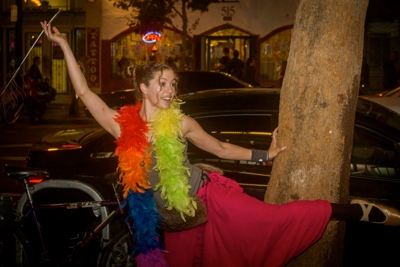
Leah Thompson, our dance performer for the night. ©David Burban
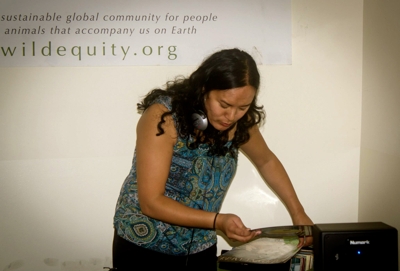
DJ Justice picking out the hot jams! ©David Burban
We had the pleasure of listening to a live performance by Kristin Plater, a very talented musician from New York. She also led us in singing “Happy Birthday” to the Franciscan Manzanita before we cut the birthday cake!
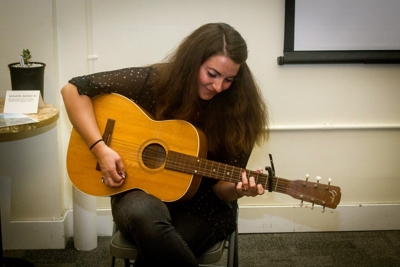
Kristin Plater singing for us and the Manzanita. ©David Burban
Many people had the lucky opportunity to meet, and take pictures with a very special guest, a close relative of the Franciscan Manzanita, the Mt. Tam Manzanita (Arctostaphylos hookeri)! We also had two guest speakers, Brett Hall, State Board President from The California Native Plant Society and Mike Vasey, Biology Professor from San Francisco State University. Videos to come real soon!
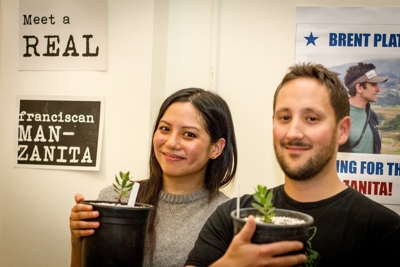
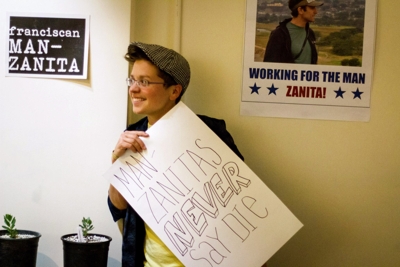
photos ©David Burban
Of course, we could not have rocked this celebration without the help of our wonderful volunteers, you know who you are. So thank you to everyone who provided a hand in the party planning! Visit our Facebook page for more pictures of the celebration.

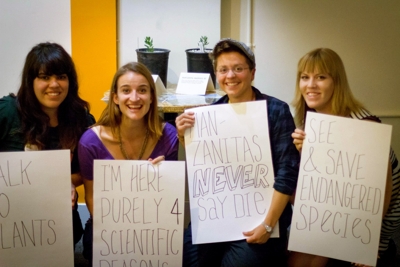
photos ©David Burban
We have many more events coming up real soon! Be sure to RSVP for our Big Year Bike Ride next week, Saturday, October 20th from 9:30 am – 12:30 pm. Sign-up for a Wild Equity account, visit our calendar, RSVP and join the Wild Equity fun!
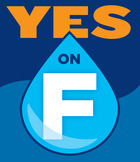
Hetch Hetchy Valley in Yosemite National Park was one of John Muir’s most treasured landscapes. But in one of San Francisco’s greatest environmental transgressions, a century ago the City built a dam across the Valley, and has been using a huge swath of the National Park as a water storage reservoir ever since.
Today San Francisco’s water supply system needs billions of dollars in upgrades, and that’s why it is the perfect time to start planning to improve San Francisco’s water conservation measures and investigate the possibility of restoring Hetch Hetchy Valley. That’s what Proposition F will encourage San Francisco to do, and that’s why the Wild Equity Institute strongly urges San Francisco voters to VOTE YES on Proposition F on November 6, 2012.
Proposition F is a forward-looking measure which calls on San Francisco to be more reliant on renewable, local water supplies, to recycle more of our water, and to encourage the use of reclaimed “greywater” by homes, businesses and local government. By decentralizing water delivery, we will reduce our dependence on faraway water sources that are jeopardized by climate change, and we can empower all San Francisco residents to take control and responsibility for this essential resource.
Opponents of this simple planning proposition have resorted to scare tactics to defeat it. This debate on KQED’s Forum between Mike Marshall of Restore Hetch Hetchy and San Francisco Supervisor Scott Wiener highlights many of these scare tactics. The Wild Equity Institute urges you to listen to Mike Marshall debunk these scare tactics so you can hear how sensible Proposition F really is. A few key points:
- Proposition F will have no impact on Camp Mather. Opponents of Proposition F have claimed that concrete from the decommissioned dam will be dumped on Camp Mather, a beloved recreation area owned and operated by San Francisco. But Proposition F doesn’t even require the dam to be removed, and certainly doesn’t require concrete to be taken from its existing location and dumped on Camp Mather. The only thing Proposition F requires is to study the possibility of restoring Hetch Hetchy Valley, so that we can make informed decisions about the future of our water supply before billions of dollars are poured into the status quo.
- Proposition F will not disproportionately impact the poor. The Wild Equity Institute spends each day redressing inequities across our human communities, and would never support a proposition that would exacerbate this concern. But some opponents have argued that Prop. F will raise water prices on the poor. There is no evidence indicating this would be the case, but if higher water rates are a possibility, that proves why Proposition F’s planning requirements deserve your vote. Only through Proposition F will San Francisco devote the thoughtful planning and oversight needed to understand this concern. If making environmental reparations is determined to be a lower priority than keeping water costs below market rates, Proposition F allows San Francisco to ultimately decide against restoring the Valley. Alternatively, it allows us to mitigate any increased costs that the City’s poor might otherwise unfairly bear, while still obtaining the environmental benefits restoring the Valley can provide. These benefits could be significant: existing studies indicate that there could be a multi-billion dollar net benefit to restoring the Valley from job creation, increased tourism, and environmental benefits.
- Proposition F will not make San Francisco’s electricity less ‘green’. Some have suggested that the dam and reservoir that destroyed Hetch Hetchy Valley should remain because it delivers ‘green power’ to San Francisco. But this is deceptive in two ways. First, the resevoir does not generate any electricity. The water in the reservoir, when released, does travel downstream through power generators that are fed by several different reservoirs. But that will not change if the Valley is restored—water will still run downstream through these facilities. Second, it borders on absurd to call any power generation that occurs through the desecration and destruction of the world’s most famous and iconic National Park ‘green’ energy.
For all these reasons, Wild Equity Institute urges all San Francisco voters to vote Yes on Proposition F on November 6, 2012!
This event has been postponed. Please stay tuned for the new date and time.
Join us Thursday, October 11, 6 pm – 8 pm at Sports Basement on Bryant St. We will be showing the moving documentary, Pale Male, the story of a notorious red-tailed hawk who made his home above a 5th Avenue apartment building in New York City. A sensational movement transpired when the building’s co-op board ordered Pale Male’s nest to be removed.
On July 24, 2012, the Wild Equity Institute filed a petition with the U.S. Fish and Wildlife Service (“Service”) urging it to change its migratory bird nest policy. The policy encourages destruction of migratory bird nests, which is prohibited by the Migratory Bird Treaty Act (MTBA). The Service’s policy has led to the destruction of countless bird nests since it was enacted, including one of a famous New York red-tailed hawk.
Join us at Sports Basement, 1590 Bryant St. to see this inspiring film, enjoy good company, snacks and drinks!

Pale Male © Lincoln Karim
Visit the Wild Equity Institute table at the WNC Wildlife Conservation Expo this Saturday, October 13, from 10 am – 5 pm. We will be tabling alongside many wonderful, environmental organizations dedicated to wildlife conservation. There will be several opportunities to meet wonderful organizations from all over the world, and hear stories about conservation efforts from the world’s most dedicated environmentalists.
Tickets to the expo are $60 general admission and $30 for students with ID. For more information, or to find out how you can get a ticket, visit wildnet.org.
We hope to see you there!
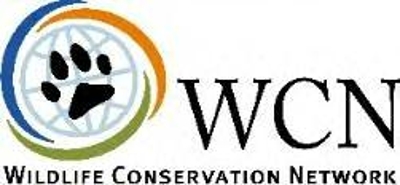

Join the Wild Equity Institute’s Executive Director Brent Plater for a panel discussion about innovative environmental education projects at the 2012 North American Association for Environmental Education Conference. The discussion begins at 8:30 a.m. on Thursday, October 11 in Junior Ballroom 4 at the Marriott City Center, 1001 Broadway, Oakland CA 94607.
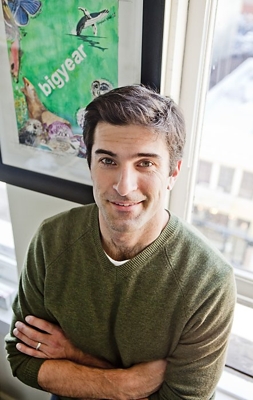
Brent Plater, Wild Equity Institute’s Executive Director
In 2011 Brent Plater and the Wild Equity Institute received a TogetherGreen Fellowship to expand the Golden Gate National Parks Endangered Species Big Year into Bay Area classrooms. TogetherGreen is a five-year partnership between Audubon and Toyota that builds conservation leadership and promote environmental action projects. This panel will discuss remarkable case studies from several TogetherGreen fellows and grantees who have successfully involve diverse audiences in conservation action. In addition to Mr. Plater, National Audubon Society’s Luisa Arnedo & Melissa Hopkins, The Ocean Project’s Wei Ying Wong, and On My Mountain’s John Robinson will discuss their work.
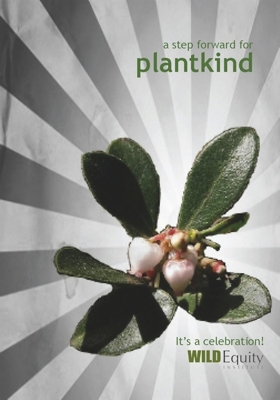
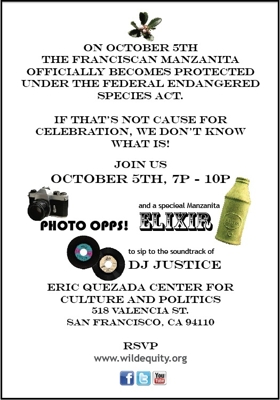
Join Wild Equity to celebrate the official listing of the Franciscan Manzanita!
Friday, the 5th of October
7:00 pm – 10:00 pm
The Eric Quezada Center for Culture & Politics
518 Valencia St.
San Francisco, CA 94110
Join us for food, specialty cocktails and music by DJ Justice!
Please R.S.V.P.
Join us at The Eric Quezada Center for Culture and Politics to celebrate this success. We’ll be drinking a new signature elixir called the “Franciscana” and dancing the “Manzanita”—a new dance move that will surely sweep the nation once the YouTube videos of the night hit the interwebs! There will be food and music, and another too rare event: an opportunity to celebrate with dozens of great people like you, people working to build healthy and sustainable global community for all!
$5 donation requested at the door.
Hope to see you all there!

San Francisco voters: the Wild Equity Institute urges you to vote NO on Proposition B.
Proposition B is a bond measure that puts the financial position of the park system at risk while implementing anti-environmental infrastructure projects in San Francisco’s last open spaces.
For years the Recreation and Park Department, particularly under the leadership of Phil Ginsburg, has pursued anti-environmental projects that lose money while mismanaging our parks:
- RPD loses up to $300,000 a year subsidizing an endangered species-killing golf course in San Mateo County.
- RPD is replacing large portions of San Francisco’s grass fields with astroturf in Golden Gate Park.
- Meanwhile, RPD doled-out thousands in overtime based on race, then settled lawsuits for $250,000 without department-wide overtime pay reform.
Because of RPD’s mismanagement, it does not have adequate funds to maintain its existing infrastructure. When operating deficits become too large to ignore, RPD tries to transform our recreation properties into revenue generating assets by proposing even more environmentally harmful development in our parks.
This vicious cycle cannot be stopped with bond money: bonds can only be used for capital projects, and cannot be used to maintain the parks we love. It can only be stopped by better management of our park system: management that prioritizes eliminating RPD’s maintenance backlog, not new construction projects RPD cannot hope to maintain.
While RPD has promised to spend capital monies on specific projects across the City, none of these projects contain the innovative urban design principles that San Francisco has become celebrated for implemented on our street scape. Rather than taking a step forward with these designs, its proposal regresses into park projects that are at best benign, and at worst antithetical to modern recreation demand and environmental sensibilities.
Even worse, Proposition B eliminates safeguards found in previous park bonds that required RPD to spend the money on projects actually proposed, so in this election voters have inadequate assurance that bond money will be spent on the specific capital projects RPD has promised.
RPD must be reformed for parks to become economically and environmentally sustainable. Burdening RPD with environmentally harmful capital projects will make its problems worse by creating more infrastructure than it can afford to maintain, leaving a degraded environment and park system in its wake.
That’s why the Wild Equity Institute is urging all San Franciscans to vote NO on Proposition B.
On October 5th, the Franciscan Manzanita will officially get federal protection under the Endangered Species Act! We’re hosting a party that day to celebrate this giant leap forward for plantkind, and you can help us make this the greatest manzanita party ever by:
· Inviting our members and supporters to the celebration
· Setting-up and tearing-down on Oct. 5
· Delivering food and party favors to the venue
· Welcoming people at the door
· Distributing flyers
· Serving food and drinks
· DJ’ing
· Photography and videography on Oct. 5
· And more!
Contact Roxanne at rramirez@wildequity.org or (415) 347-6518 if you want to help us party!
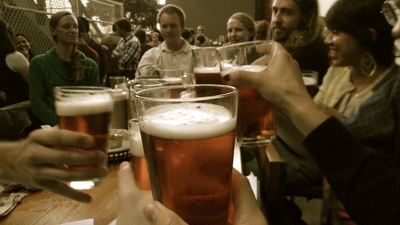
Cheers to the protection of the Franciscan Manzanita!
Grab your running shoes and join Wild Equity on a morning jog through San Francisco’s beautiful Presidio Trust to see and save threatened and endangered species.
The route will take us on an adventure to see the Gowen Cypress, the Western Snowy Plover, past the California Seablite’s restoration site, and near the Raven’s Manzanita last surviving plant. Along the way you’ll hear incredible stories about the many endangered species in the Golden Gate National Parks!
We will meet at Sports Basement in the Presidio, 610 Old Mason St., San Francisco, CA 94129. Sports Basement will also provide snacks and drinks at the end of the run! Please RSVP at this website.
This is also a perfect time to get your shopping on! On this day, customers will receive a 10% discount on purchases made at Sports Basement Presidio and 10% will be donated to support Wild Equity!
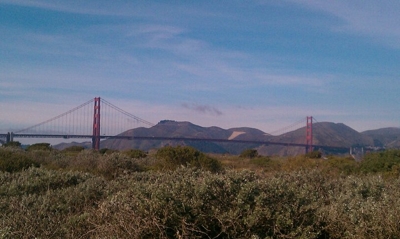
This past weekend Wild Equity went frog wild! Thank you to everyone who came out to the film night and to those who hiked with us at Mori Point. We had a great time meeting new people, searching for endangered species, and hiking the beautiful outdoors.
On Friday Wild Equity joined Sports Basement for Film Night. We watched people compete for a chance at the Hop of Fame in JUMP, a frogumentary by Justin Bookey, a film about an unusual Mark Twain-inspired tradition. In the film competitors gather to prepare for the competition of a lifetime, to see who has the farthest jumping frog in all of Calaveras County. The film was effective at depicting the passion and determination of each participant in a comical and lively way. We definitely enjoyed the laughs!
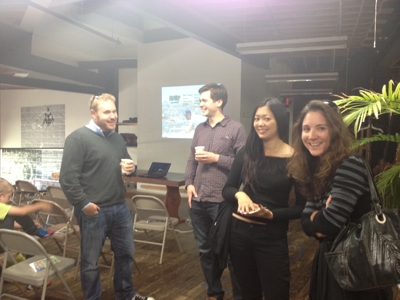
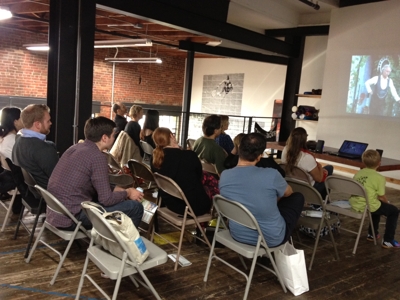
We hope to see you all at our next movie night, October 11, 2012 at Sports Basement on Bryant St from 6:00 p.m. – 8:00 p.m. We will be showing Pale Male, a documentary about the story of a beloved red-tailed hawk that inspired a sensational movement in New York City.
Read about how we are helping Pale Male.
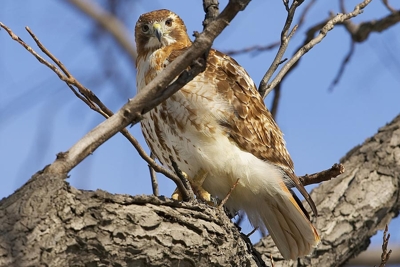
On Sunday we trekked out to Mori Point to search for the San Francisco Garter Snake, the California Red-Legged Frog, and to hear stories about the restoration vision at Sharp Park Golf Course. Many new and familiar faces joined us this morning for one epic hike. As promised, we saw the threatened California Red-legged Frog, and we were lucky enough to see a Coast Gartersnake, dolphins and a Red-shouldered Hawk.
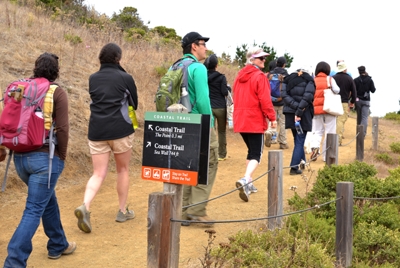
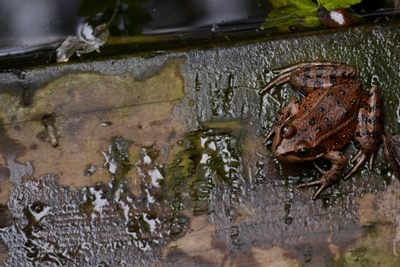
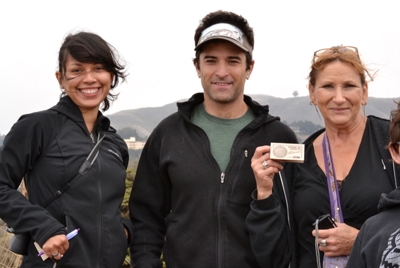
Sharon Handel wins the raffle!
Congratulations to Sharon Handel who won the raffle for a $15 gift certificate to Sports Basement!
Thank you to all who came out to support the work of Wild Equity. Sign-up for a Wild Equity account and join us on future GGNP Big Year trips to see and save endangered species, earn prizes and help us build a sustainable global community for all.
There are many ways you can contribute to the Wild Equity Institute’s campaigns and help us build a stronger environmental movement for all. Become a member, donate or volunteer today!
Congratulations to Dale Danley for being the first person to fulfill September’s GGNP Big Year conservation action item.
On September 1st, he joined the National Park Service and Wild Equity to restore habitat for the endangered San Francisco Lessingia. He helped clear away dead debris and invasive Eucalyptus trees at Lobos Creek Valley. Thanks Dale, the Lessingia is lucky to have you!

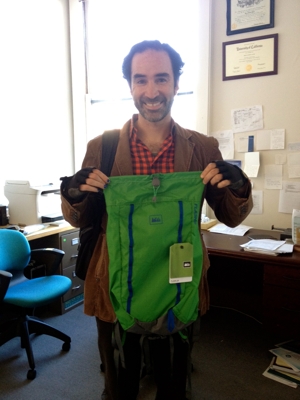
Dale is now the lucky winner of the REI Flash daypack essential for all his supplies while he’s out saving more endangered species!
You can be the next lucky prizewinner. In October, the first person to spot and record a sighting for any one of the 11 endangered plants found in the GGNP will be the winner of a Patagonia Better Sweater fleece scarf and beanie, perfect for staying warm on hikes and bike rides with Wild Equity.
Make sure you join the fun by signing up for the GGNP Endangered Species Big Year now.
You can also help by becoming a member or donating on-line today!
Wild Equity is collaborating with Downtown High School’s WALC (Wilderness Arts and Literacy Collaborative) program once again for another “Endangered Semester” where the students compete in their very own mini-Golden Gate National Parks Endangered Species Big Year.
WALC links outdoor learning and environmental education with math, art, technology and science, giving students the opportunity to learn about environmental issues, endangered species and motivates with ways they can help.
This semester, the students in WALC will have an opportunity to take multiple trips to see and save endangered species, like the Tidewater Goby and the Black Abalone, win points and prizes for their team, learn tactics for environmental activism and make sustainable and ethical life choices.

Downtown High School’s WALC students
Trip 1, Mori Point:
The first trip of the semester was to Mori Point to see and save the endangered California Red-Legged Frog and the San Francisco Garter Snake. The students had a chance to hike Mori Point and see abundant wildlife including a pod of dolphins, Brown Pelicans, and the California Red-legged Frog! The students drew wonderful pictures of the CRLFs in their field journal and reflected on ways to help.
Congratulations to the first two students who spotted and recorded the California Red-Legged Frog sighting! They will receive a $15 gift certificate to Sports Basement.
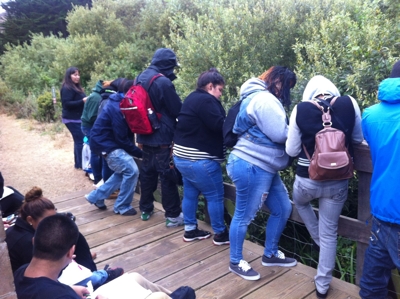
Students viewing the California Red-Legged Frogs and journaling.

Searching for the San Francisco Garter Snake.
After hearing all about the restoration vision for Sharp Park and the issues that surround the golf course, the students were inspired to write a letter to Mayor Ed Lee asking him to help save the endangered species by allowing the golf course to be restored into a National Park for all to enjoy.
We had a great time with the students and look forward to more trips soon!

Student writing letters to Mayor Ed Lee.
Thank you to everyone who joined us on Saturday as we set out to help the National Park Service monitor and restore critical habitat for the San Francisco Lessingia. This rare plant was once abundant along the vast San Francisco dunes, but due to years of damaging threats, habitat loss and invasive species, it is now critically endangered.

The rare SF Lessingia at Lobos Creek Valley.
We helped out at Lobos Creek Valley pulling invasive Ice plant (Carpobrotus edulis), clearing dead debris from the sand dunes and monitoring the species’ progress. With the help of dedicated volunteers we counted over 1,000 Lessingia plants indicating that the species is doing well at this site!
After several years of extensive restoration efforts from the NPS, volunteers and interns, the Lessingia numbers continue to rise. This is hopeful news, but because of its exclusive habitat and vulnerability to natural disasters, the Lessingia still needs much more support. Join the GGNP Endangered Species Big Year today and find out how you can help save the SF Lessingia.
You can also help us advance our mission by donating on-line or becoming a Wild Equity member today!


Volunteers monitoring the Lessingia at the Lobos Creek Valley dunes.
So far, 2012 has been extremely productive for the Wild Equity Institute. But we need you to become a Wild Equity Institute member for us to advance our mission. Take a look at what we’ve already accomplished:
- We filed a formal administrative petition to protect migratory bird nests from wanton destruction.
- We filed another to protect the San Francisco garter snake from international poachers.
- We advanced our lawsuit to protect the Antioch Dunes and surrounding communities from five power plants.
- We hosted a tailgate at Sharp Park to protest the golf course’s killing of endangered species, and then caught Assembly member Jerry Hill and San Mateo County Supervisor Carole Groom presenting forged assembly resolutions on Sharp Park: all while winning significant interim rulings in our lawsuit against the golf course.
- We helped students from San Francisco’s public schools see and help save endangered species.
- And we hosted dozens of Golden Gate National parks Endangered Species Big Year events, so we could hang out with you!
And this is just the beginning of what we can accomplish. We’ve got more ideas to build a sustainable and just world than we can implement by the end of the year!
But if you join the Wild Equity Institute today you can help us expand our work, engage new allies, and build a healthy and sustainable community for people and the plants and animals that accompany us on Earth. By joining us today you will help us close out 2012 with a bang:
- We will expand our challenge to power plants in Antioch while protecting the Lange’s Metalmark Butterfly.
- We will pass new legislation to protect San Francisco’s natural areas while creating a new National Park at Sharp Park.
- We will ensure that the Franciscan Manzanita obtains the critical habitat and endangered species protections it deserves.
- We will host endangered species bike rides, movie nights, and more to build a stronger community for conservation and justice right here in San Francisco.
We can’t do any of this without your support: please join us now and watch our campaigns thrive! Become a member of the Wild Equity Institute today. If you are already a member, consider becoming a monthly donor or making a special contribution to our work.
Thank you for all you do to help us engage and win!
Wild Equity is leading more adventures this coming September. The GGNP Endangered Species Big Year schedule is set to explore some interesting areas, and save species.
Join us on Saturday, September 1 from 9:00 a.m. – 12:00 p.m. — We will be working with the National Park Service to restore habitat for the endangered San Francisco Lessingia. Due to habitat loss and invasive species, the SF Lessingia is in critical condition. Wild Equity and the Golden Gate National Parks will help to restore and protect one of only two populations left in the world.
We will also be giving one lucky winner a REI Flash Pack 18 for helping to recover two endangered species in the GGNRA!
All you have to do is: Be the first person to either (a) help the San Francisco Lessingia by protecting and restoring one of its last two habitats, or (b) tell five people about the rare San Mateo Wooly Sunflower and its plight and be the lucky prizewinner for September!
Click on the picture for details about the prize.
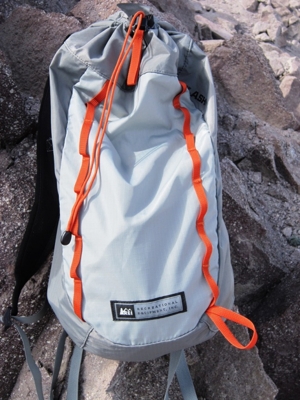
The REI Flash pack 18, the GGNP Big Year prize for September.
More events in September:
Twain’s Frog and the Beautiful Serpent:
Sunday, September 16, 2012, 10:00 a.m. – 12:00 p.m. — Hike Mori Point in search of the two most imperiled species on the San Francisco Peninsula: The San Francisco garter snake and the California red-legged frog.
Presidio Wildlife Run:
Sunday, September 23, from 9:00 a.m. -12:00 p.m. — Grab your running shoes and join Wild Equity on a morning jog through the beautiful San Francisco Presidio to see and save threatened and endangered species.
On this day, customers will receive a 10% discount on purchases made at Sports Basement Presidio and 10% will be donated to support Wild Equity!
Only one week left to claim the $25 Gift Certificate to Sports Basement. Be the first to fulfill the species requests for the month of August, record your action, and the prize is yours!
Here are the details:
In August, there are several chances to win! Be the first person to either (a) Use a reusable bag when you shop and then sign the California Plastic Bag Ban petition for the Steller Sea Lion, or (b) Ask public officials to implement a speed limit for large vessels when whales are present for the Humpback Whale, or (c ) Volunteer in the GGNP restoring riparian areas for the Central California Coast Steelhead DPS.
You must sign-up for the GGNP Endangered Species Big Year in order to be eligible to win.
Wild Equity had one exciting week hosting fun-filled events that helped bring awareness about the plight of our imperiled species. Thank you to all who came out last week to support our work and help advance our mission!
Here are the highlights of the week:
On Thursday, we headed out to the Antioch Dunes with the National Park Service and Tatzoo to partake in a Lange’s Metalmark Butterfly count. We were fortunate enough to spot 11 Metalmark Butterflies and several other native species including the Western Pygmy Blue, the world’s smallest butterfly. It was a wonderful time. Thank you to Tatzoo for organizing to save the Metalmark!
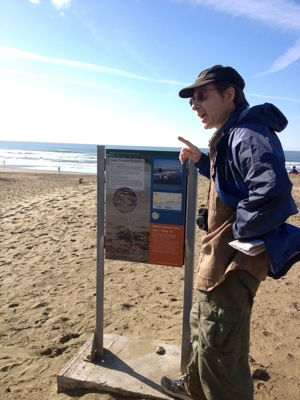

Searching for the Lange’s Metalmark Butterfly.
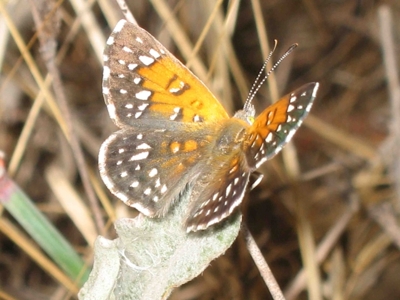
Lange’s Metalmark Butterfly, Photo © Liam O’Brien.
After a full day of hiking and butterfly counting, we joined SF Environment to host a film night where we showed The Big Year, a film inspired by the true story of three avid birders who embark on a yearlong bird-spotting competition. We had a significant turnout, met a lot of new faces, watched a cool movie, and best of all, inspired others to sign-up for the GGNP Endangered Species Big Year.
Don’t miss out on more adventures coming up in September. There are still species to save and prizes to win!

Enjoying refreshments and good conversation before the film starts.
On Saturday, Wild Equity headed out to Fort Funston to scout for endangered sea creatures. Several enthusiastic people excited about seeing some marine life joined us. The fog was thick, but that didn’t stop us from seeing Surf Scoter, Common Murre, Double-crested Cormorant, Red-tailed Hawk, Raven, Whimbrel, Heermann’s Gull and a dolphin!


At Fort Funston searching for marine sea creatures.
On Sunday we trekked over to Muir Woods to help the National Park Service restore riparian habitat for the endangered Steelhead trout and Coho Salmon. We had a blast removing invasive species in Redwood Creek, learning about the area and working with other wildlife enthusiasts. We even had a chance to search for Black Abalone, a species critically declining from overfishing, habitat destruction and withering syndrome.
Fight poaching to save the Black abalone: Ask public officials to fund game wardens and record it as a conservation action item for the GGNP Endangered Species Big Year.
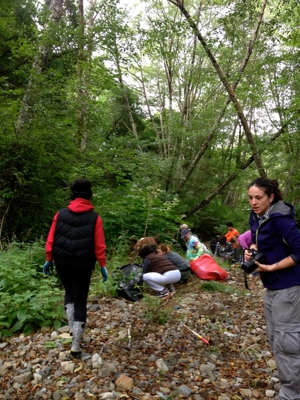
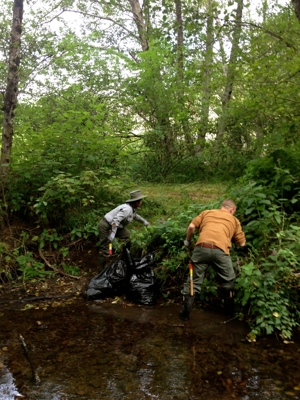
At Redwood Creek restoring habitat for the endangered Steelhead Trout and the Coho Salmon.

Brent Plater searching for Black Abalone.
Thank you to all who joined us this past week to help make a difference in the environment and protect our most precious wildlife.
There are many ways you can contribute to the Wild Equity Institute’s campaigns and help us build a stronger environmental movement for all. Become a member, donate or volunteer today!
The GGNRA Inventory and Monitoring Program is more than half way through its monitoring season for Coho salmon. Unfortunately, it appears Coho salmon smolt (young salmon) are not doing well. At Redwood Creek smolt numbers were 25% lower than expected. At Pine Gulch, a stream in western Marin County, there was a total wipeout: no smolts were counted at all.
This is particularly disconcerting because a relatively large number of redds (salmon nests) were observed last season: it appears some in-stream threat is killing Coho before they reach the smolt stage.
The future of the Coho salmon is filled with challenges, but there is hope to save this dwindling population. Join the GGNRA Endangered Species Big Year and you can help save Coho salmon while observing the animals in the wild. Sign-up for your Big Year today!

A pair of Coho salmon
The GGNRA Acquires New Land and Two Endangered Species:
In December 2011, the Golden Gate National Recreation Area obtained land at Fort Point just south of the Golden Gate Bridge in San Francisco, CA. Along with it came an opportunity to recover the endangered marsh sandwort (Arenaria paludicola).
The marsh sandwort was said to occupy this area in the early 1900’s, but because of human development and other threats, it had been completely wiped out at Fort Point, and only ten individuals were known to exist in the wild.
It was therefore crucial to restore populations to a site where they were once abundant.
With the help of volunteers, a team of biologists, U.S. Fish and Wildlife Service, and U.C. Santa Cruz, 800 marsh sandworts were recently planted at Fort Point and other wetlands in the GGNRA. The plants will need constant monitoring to measure survival rates to determine if the site is indeed an ideal location for reintroduction.
After ten years and a battle with developers, the federally recognized endangered Hickman’s potentilla will be protected and restored at Rancho Corral de Tierra, a newly acquired GGNRA property in San Mateo County.
The Hickman’s potentilla can only be found in two places: Monterey County, CA and in San Mateo County, CA. This yellow wildflower needs coastal habitat to flourish, leaving it constantly pressured by urban developers who aspire to build profit-making high-rises and golf courses.
Thanks to the Peninsula Open Space Trust (POST), who fought to keep the land in its natural state, this species and other wildlife can thrive in the GGNRA for many years to come.
Although these two imperiled species are now known to be present in the Golden Gate National Parks, they will not be added to the GGNP Endangered Species Big Year competition until the official threatened & endangered species list for the park is revised.
The National Parks need help to protect and recover the many endangered species that exist in the GGNRA. Sign-up to volunteer or join Wild Equity on a habitat restoration day.
The Wild Equity Institute is growing, and we want our Board of Directors to grow with us. We are looking for candidates to join our Board of Directors: candidates who believe in our mission and have specific skill sets to help our Board thrive.
Who are we looking for? Well, here are some specific skill sets we’d like to add to our board:
Secretary. We are looking for a candidate to become our permanent Board Secretary. The secretary takes meeting notes and keeps track of our organization records and filing requirements. The job could take up to 20 hours per year. The ideal candidate will have experience organizing corporate record books and meeting filing deadlines in a consistent, timely manner.
Treasurer. We are also looking for a candidate to become our permanent Board Treasurer. The treasurer keeps track of payroll, meeting other expense deadlines, and helps steward Wild Equity’s growing budget. The ideal candidate will have experience with fundraising planning, developing major donors, managing budgets, and meeting payroll. The job is expected to take up to 40 hours a year.
San Mateo County Residents. As our campaign to build a new national park at Sharp Park grows, we are doing more work in San Mateo County. We’d love to get more San Mateo County members and supporters on our Board to match this growth. A San Mateo County resident with experience in local political organizing and strong relationships with San Mateo County environmental partners would be ideal. This role is expected to take 10 hours a year.
Golfers. As more golfers recognize the benefits closing Sharp Park Golf Course will have on on the regional golf market, the larger our golfing constituency has become. We’d like to add some of those voices to our Board to help us explain to more golfers why closing Sharp Park Golf Course is good for the game. The ideal candidate will have experience playing public courses throughout the Bay Area, and a strong understanding of the history of golf. This role is expected to take 10 hours a year.
Think you can fill these roles, or help Wild Equity grow in other ways? Drop us a line at info@wildequity.org and we’ll get the application process started. Thanks for all your support!
Tatzoo’s Bar ‘slither’ in the Mission brought dozens of San Francisco residents together to save the San Francisco Garter Snake.

The Tatzoo team pauses at the last stop of the night.
Chanting “Restore Sharp Park!” and answering trivia questions about the financial and ecological problems posed by Sharp Park Golf Course, over 60 participants spread good cheer and showed great support for closing the course and creating a new national park on the land. Dozens of others signed postcards to the Mayor demanding he transform the land post haste.

Tatzoo’s postcards went straight to the Mayor’s office.

Participants strategize to save the San Francisco Garter Snake.
Check out all our upcoming events at our calendar and make sure you take action to help us Restore Sharp Park!
Hello Folks, Wild Equity is bringing you some exciting GGNP Big Year events in August and we need volunteers to help make them a success!
Join our phone banking party next week! From 8/13/2012 – 8/15/2012, 5 p.m. – 8 p.m., we will be calling all Wild Equity supporters to invite them to our upcoming events. We will have free drinks, dinner and wonderful company on this night!
Our August events include:
Film Night with Wild Equity and SF Environment: Thursday, August 16, 2012, 6:30 p.m. – 8:30 p.m. — Join Wild Equity and SF Environment to watch a screening of The Big Year in honor of the GGNP Endangered Species Big Year.
Sea Watch for Endangered Sea Creatures: Saturday, August 18, 2012, 10:00 a.m.-12:00 p.m. — Join Brent Plater of the Wild Equity Institute at Fort Funston to learn about the endangered marine mammals that exist within the Golden Gate National Parks.
Steelhead Restoration Day: Sunday, August 19, 2012, 9:30 a.m. –12:30 p.m. — Join the Golden Gate National Parks for a chance to see the endangered Coho Salmon,Central California Coast ESU and the Steelhead Trout, Central California Coast DPS at the Redwood Creek Watershed in Marin, Ca.
We also need volunteers to help us hand out flyers, table at events and phone bank on other nights. Be a part of the Wild Equity team and help us build a more just and fair world.
If you can help volunteer please let us know by contacting us at info@wildequity.org or call (415) 871.3953.
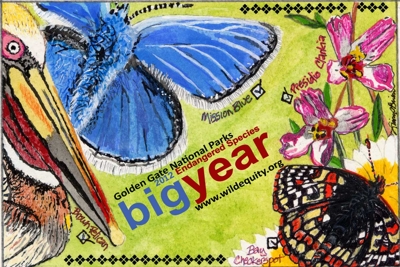
Wild Equity has finished scheduling our 2012 Golden Gate National Parks Endangered Species Big Year events—check out our guided offerings to see and save local endangered species at our events calendar.
In addition to the grand prize winners— those folks who see and save the most species by the end of the year — we are now offering several interim prizes for species sightings and conservation action items every month from now through December!
To qualify for prizes, you must get a free wildequity.org web account and then sign-up to participate in the GGNP Endangered Species Big Year. Once you are signed-up you’ll need to record your sighting or action item on the species’ corresponding Big Year page. It’s that easy!!
While you can always score points on your own, we’ve set up several events to help you climb the leaderboard. Here’s a rundown of what we have in store:
In August, Be the first person to either (a) Use a reusable bag when you shop and then sign the California Plastic Bag Ban petition for the Steller Sea Lion, or (b) Ask public officials to implement a speed limit for large vessels when whales are present for the Humpback Whale, or (c ) Volunteer in the GGNP restoring riparian areas for the Central California Coast Steelhead Distinct Population Segment and receive a $25 gift certificate to Sports Basement! Just be sure to sign-up and record your actions.
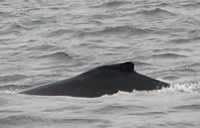

The Humpback Whale and the Steller Sea Lion
Wild Equity will be offering a chance to see and save these amazing sea creatures on our Sea Watch on August 18, at 10 a.m.
In September, the first person to either (a) help the San Francisco Lessingia by protecting and restoring one of its last two habitats, or (b) tell five people about the rare San Mateo Wooly Sunflower and its plight will be the lucky prizewinner for September!

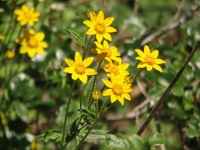
SF Lessingia (left) and the San Mateo Wooly Sunflower (right)
Wild Equity will take a trip on September 1, at 9 a.m. with the GGNP to protect and restore San Francisco Lessingia habitat at Lobos Creek Valley.
In October, the first person to spot and record a sighting for any one of the 11 endangered plants found in the GGNP will be October’s lucky prizewinner!
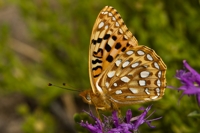


Myrtle’s Silverspot Butterfly (left), the Presidio Manzanita (center) and the Marbled Murrelet (right)
Join our Big Year Bike Ride on October 20, at 9:30 a.m. for a chance to see and save several endangered species—including some imperiled plants.
In November, see the Western Snowy Plover and protect it from harassment in its last San Francisco habitats. The first person to record a sighting for the Western Snowy Plover and ask a dog owner to leash their dog while visiting the GGNRA will be awarded November’s prize!
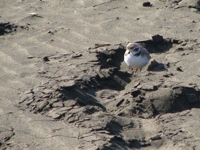
The Western Snowy Plover
Join Wild Equity on our Snowy Plover Walk at Crissy Field on November 11, at 11:00 a.m.
In December, the last month for the Big Year, be the first person to report an observation of any of our returning endangered Salmonids and receive a prize!
Remember, December is the last month to get your sightings and action items in for the GGNP Big Year! The grand prizewinner will be determined in January 2013. Sightings always need to be within the legislative boundary of the Golden Gate National Parks — sightings outside this boundary don’t count. Action items can be completed anywhere the instructions allow.
Good Luck!
Thank you to all who came out to the Big Year Happy Hour last Thursday to enjoy good food, good drinks and great company at the Southern Pacific Brewery. It was a fun-filled night catching up with the Wild Equity folks. We talked about upcoming GGNP Endangered Species Big Year hikes, bike rides, fun runs and film nights, which can all be accessed through the Event Calendar.
Congratulations to two lucky raffle winners; Shawna Casebier, who won a copy of the national bestseller The Last Child In the Woods, and Michael Starkey, who received The Laws Pocket Guide Set to the San Francisco Bay Area. Enjoy your Prizes!
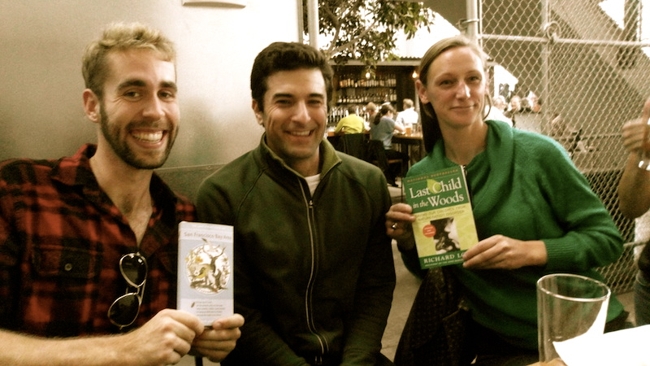
Lucky winners, Michael Starkey and Shawna Casebier, with Brent Plater.
We also toasted a bittersweet good-bye to two wonderful interns, John Bowie and Mike Linder. Thank you for all your help and dedication this summer. We wish you well on your endeavors.
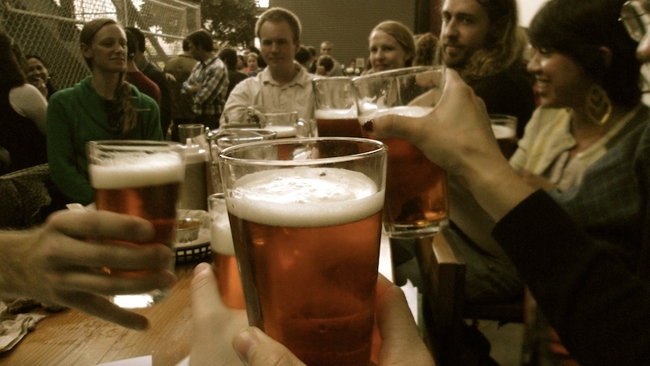
Toasting good-bye and thank you to our summer interns.
We have many more Big Year events coming up very soon. Join us by signing up for the GGNP Endangered Species Big Year now!
Signing up is a two-step process: first join the Wild Equity Institute’s on-line community to become a registered user of this website. An e-mail will be automatically sent to your e-mail account confirming your registration and giving you instructions for the next step. Second, click on the link in the e-mail automatically sent to you, and on the page where you land fill-out the form to become an official registrant in the Big Year Competition.
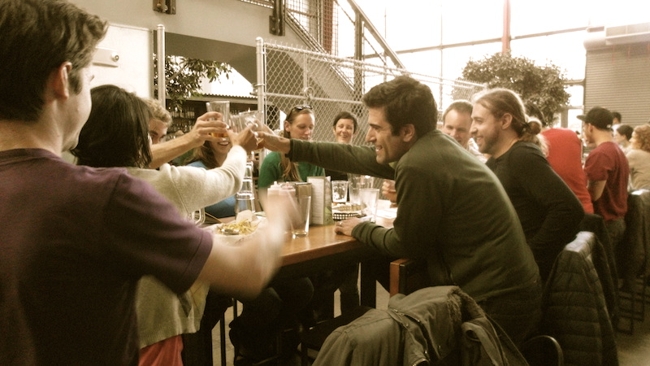
A big cheers to the GGNP Endangered Species Big Year!
Without member and donors like you, our work could not be possible. Please help us expand our work by joining us on-line today!
From May 9 through June 5, Whole Foods Market in SoMA is donating funds from its Nickels for Nonprofits program to the Wild Equity Institute!
To participate, shop at the SoMa store with your reusable bags and then donate your 5-cent bag credit to the Wild Equity Institute. It’s that easy!
The Wild Equity Institute will be one of several organizations participating in the program this month. Our work builds a healthy and sustainable global community for people and the plants and animals that accompany us on Earth. Currently our campaigns help build new national park units that save local municipalities money; they help reduce pollution burdens in disproportionately impacted communities; and they help connect people to the incredibly diverse lands in which they live.
By donating to the Wild Equity Institute through the Nickels for Nonprofits program, you’ll help our work thrive while shopping sustainably for you and your family. Thank you for your support!
Tatzoo had a wonderful Happy Hour this past Tuesday! We had a chance to meet the 2012 Tatzoo group and hear of the wonderful ongoing projects to protect the Lange’s metalmark butterfly, the San Francisco garter snake and other endangered species.
The San Francisco Garter Snake team is hosting a bar “slither” Friday, August 3, at 8 p.m. starting at The Napper Tandy, 3200 24th St., (between Cypress St. & Van Ness Ave.), San Francisco, CA 94110. Hope to see you all there!
RSVP to join the conservation efforts of Tatzoo!
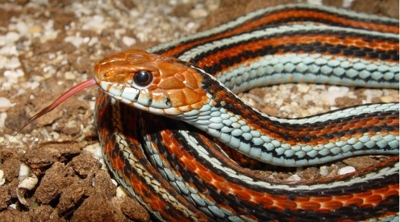
We accidentally posted the wrong date and time for the Big Year Happy Hour and Summer Intern Goodbye Party in our last edition of “From I to We: News from WEI” Sorry about that! Here is the correct information:
Big Year Happy Hour and Intern Goodbye Party: Thursday, July 26, 2012, 6;00 p.m. – 9:00 p.m. — Join Wild Equity Institute for a Big Year Happy Hour! We will enjoy good company, good food and drinks, and get updates on some exciting Big Year events Wild Equity has planned for 2012. We will also bid farewell, for now, to two incredible interns, John Bowie and Mike Linder, who have helped Wild Equity in outstanding ways!
Visit the Happy Hour event page and RSVP now. Hope to see you there!
The Wild Equity Institute received grants from two new foundations this month that will help us build a healthy and sustainable world.
The JiJi Foundation and the NITA Foundation provided grants worth over $10,000, making the work of Wild Equity possible. We are honored and humbled to have the support of these respected foundations. Thank you!
Are you a member of the Wild Equity Institute? Help us expand our work by joining us on-line today!
We are excited to announce that Dr. Douglas Bevington has joined the Wild Equity Institute’s Board of Directors. He is replacing Stan Kaufman, who served on our Board since 2009 and developed wildequity.org.

Dr. Douglas Bevington
Dr. Bevington is the Forest Program Director for Environment Now, a grantmaking foundation in California. He has a PhD in sociology from the University of California, Santa Cruz, where he taught courses on social movement studies. He is the author of The Rebirth of Environmentalism: Grassroots Activism from the Spotted Owl to the Polar Bear (Island Press, 2009), which explores how grassroots forest and wildlife protection groups have made a big impact on federal environmental policies in the U.S. over the past twenty years. He also serves on the board of directors of the Fund for Wild Nature, which helps provide resources to bold and effective grassroots groups: such as WEI!
Welcome Doug, we look forward to working with you as we build a healthy and sustainable global community for all!
The Wall Street Journal covered the Wild Equity Institute in a new article about the money-losing, endangered species-killing Sharp Park Golf Course.
Titled Big Wedge Over Sharp Park’s Future, the article describes how Sharp Park is run-down and in ill repair, and the opportunities to transform it into a better public park everyone can enjoy.
Check out the article yourself today, then add your comments here at wildequity.org or at the Wall Street Journal’s website.
The Wild Equity Institute and the Wilderness Arts & Literacy Collaborative (“WALC”) at Downtown High School recently completed another successful Endangered Species Big Semester by helping students explore the Antioch Dunes National Wildlife Refuge, learn how environmental justice victories in San Francisco are linked to a fossil fuel power plant construction boom in Antioch, and take action to help the Refuge’s endangered species recover.

WALC students remove invasive weeds at the Antioch Dunes National Wildlife Refuge.
Invasive weed growth is exacerbated by pollution from power plants that ring the Dunes.
Successful environmental justice campaigns in San Francisco led to the closure of two power plants in San Francisco’s Potrero Hill and Bayview-Hunters Point communities since 2006. In part to recoup the power lost when these power plants closed, the California Energy Commission approved five power plants, all ringing the Antioch Dunes National Wildlife Refuge. The concentration of power plants in this location threatens community health and three endangered species found at the Refuge. The Wild Equity Institute is bringing environmental justice advocates and grassroots conservation organizations together to challenge this massive power plant expansion.
On WALC’s third and final trip of the Endangered Species Big Semester, students connected our successful struggles for conservation and environmental justice in San Francisco with the new fossil fuel power plants in Antioch, observed endangered species threatened by this proposal, and then took action to help these species recover.


Students learned how to identify the endangered Antioch Dunes evening primrose and the Contra Costa wallflower.
Students were able to meet refuge managers and learn first-hand how the threats facing endangered species can be addressed in ways that build stronger ties to communities that have been traditionally underserved with environmental goods and services. Together, they contributed roughly a weeks-worth of work to the Refuge’s limited staff.

Refuge managers give students an overview of the Antioch Dunes National Wildlife Refuge.
Funded in part by the California Wildlands Grassroots Fund of the Tides Foundation & TogetherGreen (a collaboration between National Audubon Society and Toyota), the Endangered Species Big Semester gives students the chance to observe several of the Bay Area’s most imperiled species, and then help these species recover by restoring land, making healthy life style choices, and becoming participants in civic society. Bring the Endangered Species Big Semester to you school by contacting the Wild Equity Institute today.
Join the Center for Biological Diversity, San Francisco Bay Chapter of the Sierra Club, Wild Equity Institute, Pacific Institute and others as we “connect the dots” between global warming, sea-level rise, and the impacts on communities, animals and plants in a dramatic, interactive human wave at San Francisco’s restored tidal marsh Crissy Field, in the Presidio under the iconic Golden Gate Bridge.
RSVP at 350.org. Get transit directions and precise location information here.
Wear blue and bring a pair of blue jeans, a blue T-shirt or blue sheet. The wave of blue we’ll create together will dramatically illustrate sea-level rise, as well as the more frequent and severe storms, storm surges and erosion that we can expect at places like Crissy Field — unless we can start slowing climate change now. We’ll even be filmed!
The event will also feature impact “dots” — “dot” being our word for an informative poster — which will represent impacts and solutions. The “impact dots” will share facts about climate impacts on people and other species here in the Bay, including threats posed by sea-level rise, erosion and ocean acidification. Our “action/solution dots” will identify actions that can help us avoid these impacts — cutting carbon in our atmosphere by stopping the Keystone XL pipeline and Arctic drilling plans, enforcing the Clean Air Act, and restoring Sharp Park.
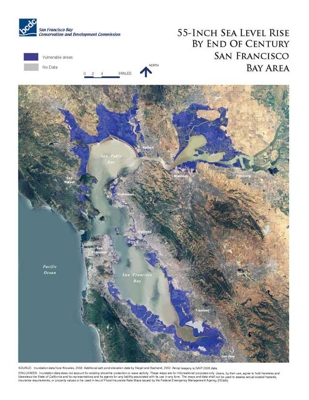
Almost 4 million Americans live less than four feet above current high-tide levels. Scientists predict approximately 2 to 7 feet of sea-level rise this century.
Marshes such as Crissy Field are particularly vulnerable to sea-level rise. In the worst-case scenario, 93 percent of San Francisco Bay’s tidal marsh could be lost in the next 50 to 100 years.
What would your rather do: give your money to the government, or to the causes you care most about? With tax deadlines fast approaching, we suspect many of you might choose the latter!
Fortunately the Wild Equity Institute makes it easy for you to contribute to our work, and get a tax break while you are at it. All while building a better world for people and the plants and animals that accompany us on Earth!
Make a generous contribution to the Wild Equity Institute today and get a head-start on next year’s tax deductions. We promise we won’t spend a dime of your hard-earned money on foreign wars, corn syrup subsides, or bridges to nowhere—a promise you know the other guys can’t keep! There are many ways you can contribute:
Become a Member of the Wild Equity Institute.
- Become a member now with a credit card or a PayPal account:

- Download a membership form and mail it to: Wild Equity Institute PO Box 191695 San Francisco, CA 94119
Become a Monthly Donor.
The best way to sustain our organization is to become a monthly donor. Monthly donations allow us to spend less time fundraising and more time building a healthy and sustainable community for all.
Go to our donate page and fill-out the form to become a monthly donor.
Give a Gift Membership.
What could be more satisfying than sharing our campaigns with someone you love? Now you can by giving a Wild Equity Institute gift membership. Just download and fill-out this form and mail it with your payment to:
Wild Equity Institute
PO Box 191695
San Francisco, CA 94119
Double Your Impact With Matching Gifts.
Many employers, large or small, will match their employees’ charitable contributions — some double or triple your gift! Whatever the program your company may have, there’s never any additional cost to you. Typically, all that is required is filling out an additional form and either sending it to WEI or submitting it directly to your employer. Contact your human resources department to see if your employer provides this benefit. If you need it, our Federal Identification Number is 27-0984775.
1% for the Planet.
The Wild Equity Institute is an approved 1% for the Planet partner. Companies who participate in this program can give 1% of sales or more to the Wild Equity Institute while satisfying the programs giving requirements. To join the program, visit the 1% for the Planet website. If you are already a member, you can donate directly to the Wild Equity Institute today.
Go Solar, Help WEI.
The Wild Equity Institute is proud to offer a new fundraising partnership with Sungevity, a solar-leasing company founded by long-time environmental activists.
For a limited time, when Wild Equity Institute members like you sign-up for a new, zero-down solar lease from Sungevity, the company will donate $500 to the Wild Equity Institute, while giving you an additional $500. That’s what we call a win-win!
To take advantage of this limited-time opportunity, all you need to do is visit the Wild Equity Institute’s special landing page on Sungevity’s website, enter your street address and answer a few simple questions to get your free installation iQuote.
For more information about this program, click here.
Volunteer.
The Wild Equity Institute always makes room for dedicated people who want to make a difference with their time. Our volunteers do everything from data entry to tabling to writing press releases to helping craft legal arguments. If you have some time to help out, contact us at info@wildequity.org and we’ll try and match your interest to our needs while meeting your schedule.
Donate Office Supplies and Furniture.
We could also use help outfitting our new office. 100% post-consumer waste and chlorine-bleach free recycled paper, envelopes, and general office supplies are always welcome. We could also use:
- Document shredders
- Flat-screen computer monitors
- Working computers with wireless networking capabilities
- Filing cabinets
- Bookshelves
If you have any supplies to donate, contact us and we’ll be happy to arrange a pick-up.
Thanks again for all you do for people and the plants and animals that accompany us on Earth! View our privacy policy.
In 2012, the Wild Equity Institute is partnering with Downtown High School’s Wilderness, Arts, & Literacy Collaborative and the Mission Beacon Center at Everett Middle School to help at-risk youth discover the connections between the plights facing their communities and the plight of our local endangered species.
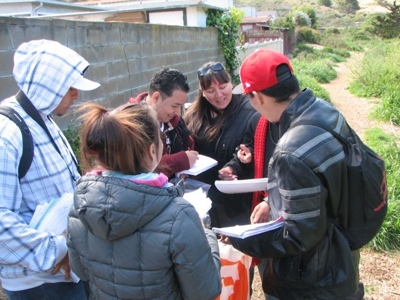
WALC’s Catherine Salvin helps students with their field journals
during an Endangered Semester trip to Mori Point.
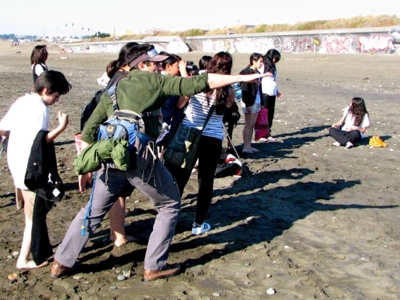
Wild Equity Institute Executive Director Brent Plater helps Mission Beacon
students find Western Snowy Plovers at Ocean Beach.
The joint project is called “Endangered Semester,” an off-shoot of the Wild Equity Institute’s signature education project, the Golden Gate National Parks Endangered Species Big Year. Generously supported by Audubon/Toyota TogetherGreen, the California Wildlands Grassroots Fund of the Tides Foundation, and Patagonia SF, the project provides students from these schools with opportunities to see and help save endangered species in the field, while earning prizes for learning how to communicate with public officials, make sustainable and healthy lifestyle choices, and take ownership of their local green spaces and parks.
To date, students have been able to search for spawning steelhead at Muir Woods, western snowy plovers at Ocean Beach, and California red-legged frogs at Mori Point. On each trip, students participated in activities that helped these species recover, while sharpening skill sets in nature observation, exercising outdoors, and communicating effectively about issues they care most passionately about.
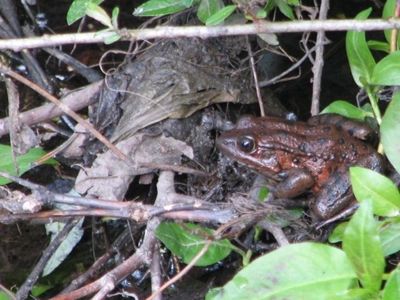
WALC students observed this California red-legged frog at Mori Point
and earned prizes from Patagonia while learning how to write effective letters.
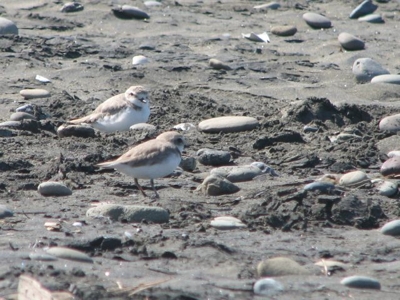
Mission Beacon students observed these Western snowy plovers at Ocean Beach
while sharpening their observation skills and learning how to coexist with wildlife in urban areas.
Four more trips are schedule for the semester, each to a site that helps students discover the root causes of harm in our communities and our remaining wild areas. In the process, the Endangered Semester helps each of us recognize how interconnected we are to each other and the lands in which we live, and provides inspiration to each of us to work for a more equitable world for people and the plants and animals that accompany us on Earth.
Winning campaigns and building a movement isn’t always easy. But we can make it rewarding. At the Wild Equity Institute, we strive to make our internships and campaigns vigorous and inspiring. But don’t take our word for it: you can hear what some of our past interns and students have to say about working with the Wild Equity Institute’s Executive Director Brent Plater in this short, super sweet video. Then apply for your internship right away!
2011 was an inauspicious year for the Bay Area’s environmental and justice movements. Park and community service budgets were slashed, and environmentally destructive developments were green-lighted by public officials around San Francisco Bay.
But I know we can reverse this trend if you join the Wild Equity Institute today. On the ground, in the courts, and at City Hall, the Wild Equity Institute succeeded against great odds in 2011. Over 70 different media outlets recognized our efforts this year; Audubon and Toyota gave me one of five prestigious TogetherGreen environmental fellowships in California; and the Sierra Club’s Arthur Feinstein observed that our turnout for the restore Sharp Park campaign was “one of the largest the environmental community has ever generated in San Francisco.”
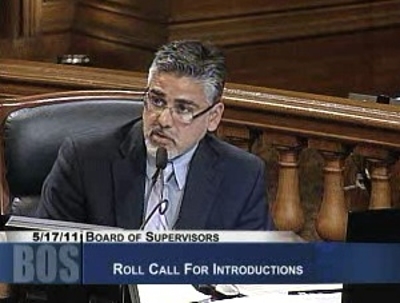
Supervisor John Avalos Helped Us Convince
the Board of Supervisors to Restore Sharp Park
We’ve built an effective organization. But we’re not here to build an organization: we’re building a powerful movement that scales-up to the massive environmental threats we face. A movement that creates a healthy and sustainable global community for people and the plants and animals that accompany us on Earth.
Movements aren’t defined by organizational effectiveness. They are defined by the inspiration, the passion, and the commitment of the people we serve. That’s why we need you to join our movement today with the most generous gift you can provide.
We are on the verge of accomplishing great things. But without you standing by our side, our potential will not be realized. And we are running out of time to build the world we believe in. In spite of our successes, 2011 brought more species to the brink of extinction, and the inequity across our human communities became larger. If our movement doesn’t grow quickly, it may soon be too late to make a difference.
That’s why I’m urging you to make your contribution to the Wild Equity Institute without delay. Because when you invest in the Wild Equity Institute, you not only get effective campaigns in return—you grow a movement that will ensure these victories aren’t snatched away by the 1%. Here are just some of the things your support will accomplish in 2012:
| A GGNP Endangered Species Big Year — We’re providing urban youth who have not succeeded in traditional classrooms an opportunity to see and help save the GGNRA’s endangered species, while discovering the enviornmental justice concerns that led to the creation of this great national park. But if we don’t raise another $1,000 by the end of the year, we will have to cut-back on the prizes and events that made this program so special in 2011. Each event builds our movement’s constituency, making this funding more urgent then ever. | 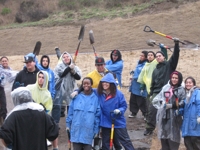 |
| Sharp National Park — While the Mayor vetoed our legislation, he can’t stop our movement. Soon the golf developers’ tenuous grip on public officials will be overwhelmed by our rapidly growing movement. But we need your support to win our cutting-edge litigation and grassroots campaign. Last week, self-described “golf purist” and millionaire Sandy Tatum told the press that “we’re going to fight this like hell … and we’ve got access to money.” Unless you stand with us, the 1% will throw their wealth around and take this park from you—so they can continue to play a game on your dime. | 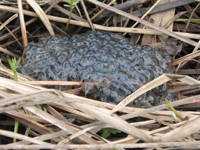 |
Imagine the world we will build together: a more equitable world for people and the plants and animals that accompany us on Earth. Thank you for supporting the Wild Equity Institute today!
Sincerely, Brent Plater Executive Director |
 |

Contact:
Elizabeth Sorrell (212) 979-3185
Kaberi Kar Gupta (559) 357-3157
Mira Manickam (609) 356-3908
Brent Plater (415) 572-6989
John C. Robinson (707) 688-2848
Ian Signer (917) 843-2759
Five California Environmentalists Singled Out for Leadership
Honorees Receive Audubon/Toyota TogetherGreen Fellowships
New York, NY, November 16, 2011 – Five California residents are the recipients of a national fellowship that will enable them to help build on conservation work in the state.
Supported by a conservation alliance between Audubon and Toyota, the TogetherGreen Fellowship offers specialized training in conservation planning and execution, the chance to work and share best practices with gifted conservation professionals, and assistance with project outreach and evaluation. Each Fellow receives $10,000 towards a community-focused project to engage local residents in conserving land, water and energy, and contributing to greater environmental health.
Five of this year’s 40 TogetherGreen fellows include:
- Brent Plater, Executive Director, Wild Equity Institute
With the help of his TogetherGreen Fellowship, Plater will expand upon the Golden Gate National Parks’ Endangered Species Big Year, a program he founded in 2008 that created a race against time to see and help save each of the 36 endangered and threatened species found within the Parks. This year’s Big Year will teach valuable job and naturalist skills to participants in a group setting, with a focus on underserved youth, a group he is passionate about reaching and with whom he has already seen success in the program.
- Kaberi Kar Gupta, Board Member Fresno Audubon
With her TogetherGreen Fellowship, Kaberi Kar Gupta will lead the Fresno Audubon Community Greenscape Program, a collaborative, volunteer-driven, residential landscape transformation process. Building on efforts already in place in Fresno, Kar Gupta will reach out to underrepresented homeowners as well as the urban upper socioeconomic class homeowners, landscape architects, nonprofit organizations, institutional policy makers and other community members to engage them in comprehensive water wise yard landscape management through focus groups, informational workshops and residential greenscaping transformation workday events. Kar Gupta’s goal with the Community Greenscape Program is to build a dynamic and active coalition of local government, low income housing developers, community organizations, educational institutions, and environmental groups helping to create a more sustainable environment. Through this program, she will help homeowners install water conserving native plants in their yards, providing enhanced biodiversity and new habitat for birds.
- Mira Manickam, Field Science Educator, Headlands Institute
As a TogetherGreen Fellow, Manickam will launch a program called “Green Team” targeted at-risk youth Oakland who have faced homelessness, addiction, incarceration, unstable homes, or who have few job prospects. In partnership with United Roots, the program will focus on job-skill training and planting projects in the community. Green Team will draw upon the Roots of Success Curriculum developed by the Environmental Literacy Curriculum Project to engage disenfranchised communities in the green economy. Training will also draw upon United Roots strengths in media production, and include workshops with other participants in the center to document through music and video the work of the Green Team. The program will host a yearly community planting celebration showcasing the Green Team’s planting work and media produced at the center around it.
- John C. Robinson, President, On My Mountain
Robinson will be utilizing his TogetherGreen Fellowship to continue his quest to share his knowledge and love of nature and birds with inner city youth. Robinson will create an environmental “Starter Kit” that will include, among other items, his book, Birding For Everyone. He will work closely with Audubon Centers and leverage connections with other conservation organizations and agencies to expand awareness and effectiveness of this program. Partners in Flight, which has a proven track record in engaging students in conservation projects, will be a key collaborator in supplying projects, educational materials, and conservation plans for youths to implement. This network, in combination with Robinson’s exposure in the media, could potentially broadcast his environmental message to several million homes.
- Ian Signer, Associate Education Director, California Institute for Biodiversity
For his Fellowship Project, Signer will work in his home state, connecting an underserved community to the conservation of habitat for the Lange’s metalmark, a local butterfly on the brink of extinction. He’ll be working close to where he grew up, in Eastern Contra Costa County (East County), an economically depressed region founded on coal mining in the late 1800s. Industries such as PG&E and DOW Chemical continue to be important, where they employ much of the diverse local population. Signer will host an ecology institute in collaboration with the East Bay Regional Park District, Delta Science Center, and California State Parks, focusing on empowering educators to contribute to local conservation through hands-on investigations and citizen science. He’ll focus on providing tools, training, mentorship, and formative evaluation that will help translate sometimes abstract conservation concepts into concrete community action.
“This Fellowship funding will provide Oakland teens with a fresh approach to nature, creating an empowering and enriching experience and a long-lasting, culturally relevant point of reference for years to come.” said Manickam.
“The TogetherGreen fellowship is a perfect match for the Wild Equity Institute’s mission: to unite conservation and justice movements into a powerful force that builds a healthy and sustainable global community for all,” said Brent Plater, Executive Director of the Wild Equity Institute. “The grant will help us connect urban youth to the Golden Gate National Recreation Area’s environmental justice creation story and the biological richness of these lands.”
“California is a clear powerhouse of passionate individuals who want to make a difference in the health of our environment,” said Audubon President David Yarnold. “These Fellows have the passion and the skills to inspire others, exactly the kind of people the environmental community needs to tackle the huge challenges and opportunities confronting us.”
Fellowship recipients were chosen from a large pool of highly qualified individuals. All were required to have at least six years of experience in conservation, environmental education, policy, or related issues; a demonstrated passion for conservation and a proven track record of reaching previously underserved audiences. Applicants also need to express a desire to learn and grow. An advisory committee composed of conservation professionals and experts in environmental education, communications, outreach, and conservation planning made selections.
A complete list of the 2011 TogetherGreen Fellows can be found at www.TogetherGreen.org/fellows.
###
About TogetherGreen
Audubon and Toyota launched the five-year TogetherGreen initiative in 2008 to build the promise of a greener, healthier future through innovation, leadership and volunteerism. For more information, visit www.togethergreen.org.
About Audubon
Now in its second century, Audubon connects people with birds, nature and the environment that supports us all. Our national network of community-based nature centers, chapters, scientific, education, and advocacy programs engages millions of people from all walks of life in conservation action to protect and restore the natural world. Visit Audubon online at www.audubon.org.
About Toyota
Toyota (NYSE: TM) established operations in the United States in 1957 and currently operates 10 manufacturing plants, including one under construction. Toyota directly employs nearly 30,000 people in the U.S. and its investment here is currently valued at more than $18 billion, including sales and manufacturing operations, research and development, financial services and design.
Toyota is committed to being a good corporate citizen in the communities where it does business and believes in supporting programs with long-term sustainable results. Toyota supports numerous organizations across the country, focusing on education, the environment and safety. Since 1991, Toyota has contributed over half a billion dollars to philanthropic programs in the U.S. For more information on Toyota’s commitment to improving communities nationwide, visit http://www.toyota.com/community.
As our second full year draws to a close, the Wild Equity Institute has had several remarkable successes. And people are noticing. Over 70 different media outlets covered our work in 2011, including a cover story in the San Francisco Chronicle, an appearance on KQED’s Forum with Michael Krasny, and features in the New York Times and Los Angeles Times.
We’ve also built a sound financial model with growing foundation support. This year Patagonia awarded us the San Francisco store’s Voice Your Choice grand prize, and our executive director was one of five Californian’s to receive a TogetherGreen fellowship for environmental leadership.
As remarkable as our second year has been, our work is not complete: and we need your support to continue. If you’ve been waiting to see if our theory of change can work, I think our recent results will inspire you to join now, just as media outlets and foundations have been compelled to cover and fund our efforts. I want you to become a Wild Equity Institute member today: with you standing with us, 2012 will bring more campaign victories that build a stronger environmental movement for all.
The Wild Equity Institute believes we can achieve extraordinary environmental victories while building a larger, more resilient environmental movement. Throughout 2011, we implemented this theory by uniting grassroots conservation and environmental justice groups in campaigns that build a healthy and sustainable global community for people and the plants and animals that accompany us on Earth. When you contribute to our work you achieve measurable environmental gains on the ground: and you ensure that our movement grows so that the scale of our efforts can match the size of the threats facing our communities, our landscapes, and the Earth.
The Wild Equity Institute is a nimble, efficient organization with a precise vision and the skills needed to get the job done right. We utilize our funds with great thrift. But movements are not defined by the effectiveness of organizations. They are defined by the inspiration, the passion, the commitment of the people these organizations serve.
This is why we need you to join our movement today with the most generous gift you can provide. Our memberships start at $35 annually, and every dollar is invested into campaigns that redress inequity, both across our human communities and towards the lands in which we live.
Thank you for all your support!
Become a Member of the Wild Equity Institute.
- Become a member now with a credit card or a PayPal account:

- Download a membership form and mail it to: Wild Equity Institute PO Box 191695 San Francisco, CA 94119
Become a Monthly Donor.
The best way to sustain our organization is to become a monthly donor. Monthly donations allow us to spend less time fundraising and more time building a healthy and sustainable community for all.
Go to our donate page and fill-out the form to become a monthly donor.
Give a Gift Membership.
What could be more satisfying than sharing our campaigns with someone you love? Now you can by giving a Wild Equity Institute gift membership. Just download and fill-out this form and mail it with your payment to:
Wild Equity Institute
PO Box 191695
San Francisco, CA 94119
Double Your Impact With Matching Gifts.
Many employers, large or small, will match their employees’ charitable contributions — some double or triple your gift! Whatever the program your company may have, there’s never any additional cost to you. Typically, all that is required is filling out an additional form and either sending it to WEI or submitting it directly to your employer. Contact your human resources department to see if your employer provides this benefit. If you need it, our Federal Identification Number is 27-0984775.
1% for the Planet.
The Wild Equity Institute is an approved 1% for the Planet partner. Companies who participate in this program can give 1% of sales or more to the Wild Equity Institute while satisfying the programs giving requirements. To join the program, visit the 1% for the Planet website. If you are already a member, you can donate directly to the Wild Equity Institute today.
Go Solar, Help WEI.
The Wild Equity Institute is proud to offer a new fundraising partnership with Sungevity, a solar-leasing company founded by long-time environmental activists.
For a limited time, when Wild Equity Institute members like you sign-up for a new, zero-down solar lease from Sungevity, the company will donate $500 to the Wild Equity Institute, while giving you an additional $500. That’s what we call a win-win!
To take advantage of this limited-time opportunity, all you need to do is visit the Wild Equity Institute’s special landing page on Sungevity’s website, enter your street address and answer a few simple questions to get your free installation iQuote.
For more information about this program, click here.
Volunteer.
The Wild Equity Institute always makes room for dedicated people who want to make a difference with their time. Our volunteers do everything from data entry to tabling to writing press releases to helping craft legal arguments. If you have some time to help out, contact us at info@wildequity.org and we’ll try and match your interest to our needs while meeting your schedule.
Donate Office Supplies and Furniture.
We could also use help outfitting our new office. Recycled paper, envelopes, and general office supplies are always welcome. We could also use:
- Bookshelves
- Working computers with wireless networking capabilities
- Filing cabinets
If you have any supplies to donate, contact us and we’ll be happy to arrange a pick-up.
Thanks again for all you do for people and the plants and animals that accompany us on Earth! View our privacy policy.
The Golden Gate National Recreation Area has released its long-awaited Dog Management Plan, and will be taking public comment on the proposal for the next 90 days. The Wild Equity Institute’s Executive Director Brent Plater will be a guest on KQED’s Forum (88.5 FM) to discuss the plan Monday, January 17th at 9:00 a.m. You can bring your voice to the debate by calling 866-733-6786 or emailing forum@kqed.org.
Weighing-in at over 2,000 pages and over six years in the making, bystanders might look at the plan and conclude that the GGNRA’s priorities are misplaced. If, for example, the GGNRA tackled more pressing environmental problems like climate adaptation this thoroughly, we might have a carbon neutral park by now.
Yet in other respects pet management contains the same moral dilemmas as our most pressing environmental problems:
- Who should bear the burden of activities conducted in National Parks: the individuals taking action or the public as a whole?
- When should individual entitlement take precedence over public responsibility?
- Does the Park have a duty to proactively protect park visitors from harm, or should the Park simply facilitate recompense after an injury has occurred?
These are common questions to most environmental problems, yet despite the plan’s length and delay, it still fails to address some basic problems with pet management at the GGNRA.
Off-leash dogs have long been negatively impacting people, our pets, wildlife, and park resources at the GGNRA. Imperiled wildlife like the western snowy plover are frequently harassed by off-leash dogs; guide dog users are regularly interfered with—and occasionally attacked—by off-leash dogs; and perhaps most alarmingly, hundreds of off-leash dogs have been lost, injured, or killed when they fall off cliffs, run into traffic, or otherwise lose their owners.
“The proposed plan contains some improvements, but fails in significant respects to protect people, our pets, wildlife, and park resources,” said Plater. “The first rule of good off-leash dog park design is to make sure our dogs are safe. But the dog play areas proposed by the Park Service do not contain safety barriers, do not require dog owners to certify that their dogs are trained before allowing them off leash, and the plan’s basic structure is to wait for park visitors to be injured before protective measures are put in place. We look forward to working with the Park Service to correct these obvious flaws before the plan is finalized.”
Sensible management measures like enclosing dog play areas with fences or other physical barriers can resolve many of these problems, and give park visitors the opportunity to choose off-leash dog experience on their own terms, rather than having the choice imposed upon them. Already animal welfare groups like the ASPCA, PETA, American Humane Association, Action for Animals, and Dogs Deserve Better have called for leash law enforcement at the GGNRA. Over the next 90 days you’ll have the opportunity to add your voice to theirs by submitting comments in support of leash law enforcement in the Park. Don’t delay: make your comments today!
- September 14, 2011, 7:30 p.m.—Shaping San Francisco: Endangered Species Campaigning: Shaping San Francisco/CounterPULSE hosts a discussion about endangered species campaigning with Todd Gilens, creator of the Endangered Buses art project; Brent Plater, Executive Director of the Wild Equity Institute; and Jessie Raeder of the Tuolomne River Trust. You’ll learn about some of the most pressing issues facing San Francisco’s local endangered species, and how you can become part of the solution and help these species thrive. RSVP for the event here.

Todd Gilens Endangered Buses Project.
At the Wild Equity Institute, we are working to build a better world based on a shared moral foundation: equity, and the desire to create a more just and fair world. Bridging moral foundations and unifying our moral concerns was a theme of Dr. Martin Luther King Jr.‘s work. This short video of Dr. King’s message of unity inspires us forty years later to keep building a healthy and sustainable global community for all.
In 2011, the Wild Equity Institute partnered with Downtown High School in San Francisco to give students and endangered species a second chance at life. The joint project was called “Endangered Semester,” and it provides students who have not succeeded in traditional classrooms an opportunity to see 10 endangered species in the field, while taking 10 actions that help these species recover. It was a competitive event: as the students see and help save endangered species, they earn prizes that help their class succeed.
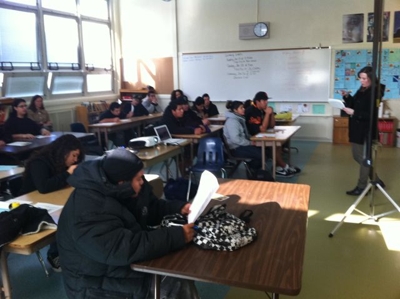
Endangered Semester Presentation at Downtown High School
The Endangered Semester was completed in four phases. First, students were provided an in-class description of the project, including specific instructions on how to see endangered species in the field ethically and how to complete actions that help species recover. Next students were taken on three field trips to observe species and conduct recovery actions. Third, students were provided with self-directed opportunities to see endangered species near their homes, and make healthy lifestyle choices that would also benefit conservation. Finally, the students’ scores were tallied and prizes awarded in an end of the semester celebration.
On January 13, 2011, students completed their first trip to help see and save Coho Salmon at Muir Woods National Monument and Muir Beach. Although inclement weather made it difficult to spot salmon, the students marshaled on and planted 120 native plants along creek beds to help improve spawning habitat for the anadromous fish.
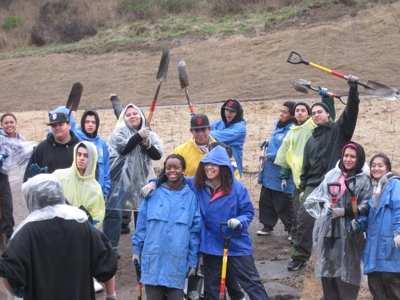
Downtown High School Students Celebrate in Muir Woods
On March 11, 2011, Wild Equity led students on a challenging coastal hike to see several endangered species in San Francisco. Over the five-mile journey, students saw several restoration sites in the Presidio, searched for several plants, birds, and marine mammals on the brink of extinction, and learned about the great environmental justice concerns that led to the creation of the Golden Gate National Recreation Area.

Wild Equity Institute Executive Director Brent Plater
Leads Downtown High School Students On an Endangered Species Hike in the Presidio
On April 22, 2011, students were taken to the Antioch Dunes National Wildlife refuge to see two endangered plants and take actions that help conserve the endangered Lange’s metalmark butterfly, arguably the rarest Bay Area butterfly. Students were given special access to this refuge, usually closed to visitors, and met with Fish and Wildlife Service staff working desperately to save endangered species near communities impacted by industrial development.
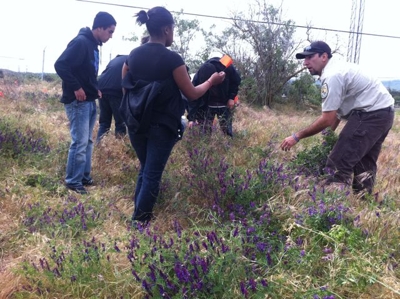
Louiz Terrazas of the U.S. Fish and Wildlife Service Instructs Students
on Plant Identification at the Antioch Dunes National Wildlife Refuge
After completing their actions and sightings, the students points were tallied, interim prizes were awarded, and a celebration was held to close out the Endangered Semester. All together, students completed about 100 sightings and action items during the semester: an impressive feat that earned them nature- and education-themed prizes individually and for the class as a whole.
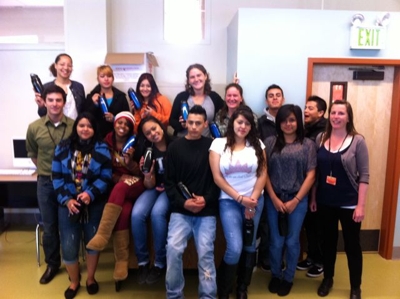
Downtown High School Students Show-off Prizes at the End of Semester Celebration
The Endangered Semester was made possible by a generous gift from the California Wildlands Grassroots Fund of the Tides Foundation. Additional support was provided by REI’s San Francisco store and the Sports Basement. If you are interested in having your school participate in the endangered semester, contact us and we’ll let you know how to get your classroom enrolled.
RSVP at wildequity.org
Saturday, May 14, 2011
9:00pm-1:30am
Grant & Green Saloon
1371 Grant Ave
San Francisco, CA 94133
(between Green St & Vallejo St)
North Beach/Telegraph Hill neighborhoods
Enjoy music by:
The New Thoreaus
Sufis
The Great Sand Waste
Come to the Grant & Green Saloon for an evening of great music, smooth libations, and good company to support the Wild Equity Institute, a San Francisco-based non-profit organization building a healthy and sustainable global community for people and the plants and animals that accompany us on Earth! No cover, but donations are accepted, and 25% of the bar goes to WEI.
Sorry, ages 21+ only. Inebriation not recommended. Don’t drink and drive: so bring a straight-edge friend or prep for a taxi ride.
For more information contact the Wild Equity Institute at 415-349-5787 or info@wildequity.org.
The people have spoken: and they have selected the Wild Equity Institute to receive Patagonia San Francisco’s $2,500 grand prize!
The store’s third annual “Voice Your Choice” campaign invited Patagonia’s shoppers to cast votes and determine how the store should distribute $5,000 in grant money to three local environmental organizations. The Wild Equity Institute was awarded $2,500, and the second- and third-place organizations received $1,500 and $1,000 respectively.
“We are grateful to Patagonia San Francisco for selecting us for the program, and honored that so many of its customers support our work,” said Brent Plater, Executive Director of the Wild Equity Institute. “Patagonia has a rich tradition of supporting cutting-edge environmental organizations, and we’ll continue that tradition by uniting the grassroots conservation and environmental justice movements in shared campaigns that create a more equitable world for all.”
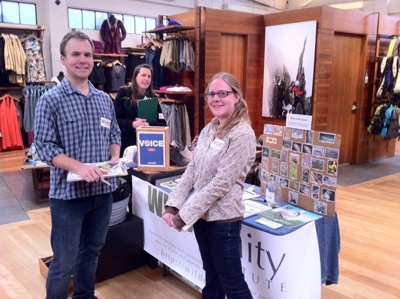
Volunteers John Bowie, Barbara Beth, and Courtney Rose Rump table at Patagonia San Francisco.
In addition to the Wild Equity Institute, San Francisco Surfrider and TransForm competed in the Voice Your Choice program. Votes were accepted at the store in San Francisco from March 10 through March 24. Participants could cast one vote per store per visit. No purchase was necessary. At the close of voting, the Wild Equity Institute was announced as the grand prize winner, with San Francisco Surfrider and TransForm announced as the runner-up and third place winners, respectively.

Patagonia retail stores in 27 communities throughout the country particiapted in the Voice Your Choice program as part of the company’s support for environmental organizations. Patagonia’s Environmental Grants Program has generated more than $38 million in grants since 1985 by donating 1% of annual sales to environmental organizations worldwide.
The Wild Equity Institute unites the grassroots conservation and environmental justice movements in shared campaigns that redress inequity, both across our human communities and towards the lands in which we live. Special thanks to Barbara Beth, John Bowie, and Courtney Rose Rump for helping reach Patagonia’s customers during our two days of tabling at the San Francisco store.
You can help the Wild Equity Institute earn $2,500: simply by shopping at Patagonia’s San Francisco store! Just visit Patagonia San Francisco from March 10 through March 31 and cast your ballot for Wild Equity during Patagonia’s Voice Your Choice program.

The Voice Your Choice program encourages Patagonia customers to become better informed and more involved with environmental work in their communities. That’s why Wild Equity is such a great match for the program: our work helps build community every day by engaging people to care for each other and for other forms of life.
WEI is one of three local organizations selected to participate in Patagonia’s Voice Your Choice program this year, a great honor for our nascent group. Through this program WEI is competing to win up to $2,500: we take home the grand prize if we have the most supporters visit the Patagonia San Francisco store and cast a ballot for the Wild Equity Institute. The second and third place organizations receive $1,500 and $1,000, respectively.
We’ll be tabling at the store on March 13 and March 19 from noon until 4pm to drum-up support for our work restoring Sharp Park, defending San Francisco Bay from sea level rise, and protecting equitable access to our public parks.
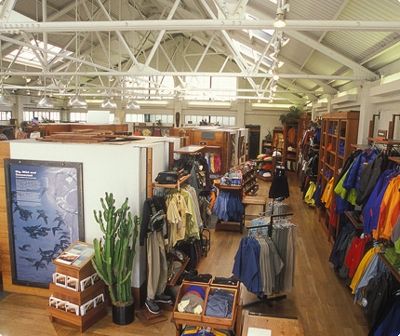
Patagonia’s San Francisco store is located at 770 North Point, San Francisco, CA 94109.
Click here for driving directions.
Stop by and see us, cast your ballot, and give thanks to Patagonia for its exceptional generosity to people and the plants and animals that accompany us on Earth! You can cast your vote even if we aren’t there, but you may only vote once per visit to the store during the voting period. Of course, multiple visits to the store by Wild Equity supporters are encouraged!
This Thursday, February 17 at 7pm, the Wild Equity Institute’s Executive Director will present a slideshow with Eddie Bartley of Nature Trip about Brent’s Fulbright Scholar experience in Trinidad and Tobago. The presentation will be at the First Unitarian Universalist Church in San Francisco: hope to see you there!
- Birding, Turtling, & Conserving Trinidad & Tobago, Thursday, February 17, 7:00 p.m. to 8:30 p.m.: The Wild Equity Institute’s Executive Director Brent Plater received a Fulbright Scholar grant to study leatherback sea turtle conservation in Trinidad and Tobago in 2010. While he was there, nearly 20 Bay Area conservationists visited to explore the country, including Eddie Bartley and Noreen Weeden of San Francisco Nature Trip. Eddie and Brent have put together this slide show of the experience, documenting the amazing wildlife, incredible culture, and heart-wrenching problems in T&T—and the inspiring people that are doing something about it. Held at the First Unitarian Universalist Church in San Francisco. Admission is free.
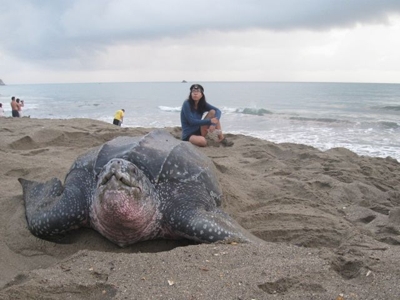
Nesting Leatherback Sea Turtle, Trinidad & Tobago
Thanks to the 75+ supporters of the Wild Equity Institute and our suite mates, Restore Hetch Hethcy, that helped warm our office and bring the 2010 GGNP Endangered Species Big Year to a close.
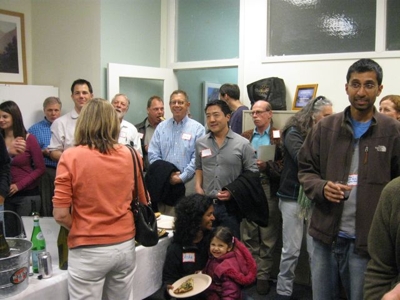
Members enjoyed delicious foods and wines generously donated by
Arizmendi Bakery and Muir-Hanna Vineyards
We spent some time honoring our Big Year winners: Steve Price and Liam O’Brien were once again crowned co-champions, while Molly Latimer won a free pair of binoculars from REI’s San Francisco Store for being the top youth competitor. Kate and Gofi Gelles rounded out the top five finishers in the Big Year competition. Congratulations to you all!
And we couldn’t have done it without the support of Barbara Beth, who received special acknowledgement as the Wild Equity Institute’s Volunteer of the Year for 2010!
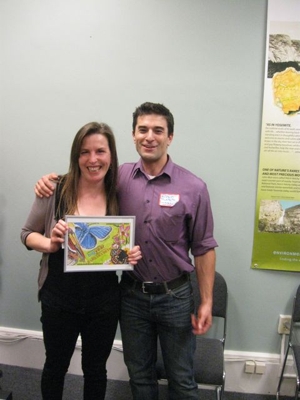
Barbara Beth and Brent Plater
Thanks to everyone who came out and celebrated with us. Here’s to a big 2011!
Throughout 2010, the Wild Equity Institute is building 2,000 members at a special $10 rate. It is an incredible—but essential—bargain: we offer free programs that build a healthy and sustainable global community for people and the plants and animals that accompany us on Earth, but we can’t do it without you. Will you become a member by making a financial contribution today on-line or through the mail? Thanks for your support!
We can’t thank you enough for supporting our campaigns to build a more equitable world for people and the plants and animals that accompany us on Earth. In honor of the year 2010, our first full year in operation, the Wild Equity Institute is building 10 founding supporters who will donate $2,000 each and 2000 members who will donate $10 each to help us fulfill our mission. And for those of you looking for a level of support that is just right, we’re rounding out our campaign by building 100 supporters who will contribute $100 each to WEI. If you are interested in becoming a founding supporter, a member, or contributing to our work at any level please make a contribution today and help our programs thrive!
We’ve added new functionality to our website: now you can share Wild Equity Institute news clips with your friends on Facebook with a simple mouse click, and you can do the same every time you enter an action item or species sighting for the GGNP Endangered Species Big Year! Try it out and let us know what you think!
The Wild Equity Institute has partnered with Downtown High School in San Francisco to give students and endangered species a second chance at life.
“We’ve been inspired by the students at Downtown High School and the empathy they’ve shown toward each other and to other forms of life,” said Brent Plater, Executive Director of the Wild Equity Institute. “We’re grateful for the opportunity to help them succeed both in and out of the classroom.”
The joint project is called “Endangered Semester,” and it provides students who have not succeeded in traditional classrooms an opportunity to see 10 endangered species in the field, while taking 10 actions that help these species recover. It is a competitive event: as the students see and help save endangered species, they earn prizes that help their class succeed.

Endangered Semester Presentation at Downtown High School
On January 13, 2011, students completed their first trip to help see and save Coho Salmon at Muir Woods National Monument and Muir Beach. Although inclement weather made it difficult to spot salmon, the students marshaled on and planted 120 native plants along creek beds to help improve spawning habitat for the anadromous fish.
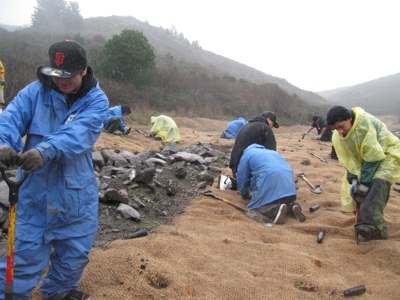
Downtown High School Students Restore Native Plants
Along a Tributary of Redwood Creek
In addition to Muir Woods, students will visit the Antioch Dunes National Wildlife Refuge and the Presidio of San Francisco this semester. During each visit students will be given opportunities to see imperiled wildlife, developing nature observation and field skills in the process. Students are also given diverse tasks to help these species recover, including restoring habitat, contacting public officials, and making healthy lifestyle choices.

Downtown High School Students Celebrate Restoration Work for Coho Salmon
The Endangered Semester was made possible by a generous gift from the California Wildlands Grassroots Fund of the Tides Foundation. Visit https://www.wildequity.org for more information about the project as the semester progresses.
The Wild Equity Institute is making it easier to follow our work: we’re now on Facebook and Twitter! Become a Fan of the Wild Equity Institute on Facebook and follow us on Twitter to get the latest news about our work.
The United Nations has declared 2010 as the International Year of Biodiversity, and now the International Union for Conservation of Nature (IUCN) has listed the Golden Gate National Parks Endangered Species Big Year as one of the best conservation ideas of the year!
Now you can vote online to put the Big Year at the top of the list. Click here to make the GGNP Endangered Species Big Year the number one international conservation project of 2010!
The IUCN’s Countdown 2010 project aims to raise public awareness about biodiversity loss while empowering governments and citizen groups to halt the extinction crisis by achieving goals set forth in existing international treaties and agreements. As part of the project, the IUCN is highlighting innovative conservation ideas to inspire others to reconnect with nature and halt biodiversity loss.
Over 1,000 partners across the globe, including the Wild Equity Institute, have become a part of Countdown 2010, but only a limited number have projects listed among the best conservation ideas of the year. Vote now for the Big Year to put us at the top of the list!
Federal tax returns are due this week, and there’s no better way to reduce your tax exposure than by donating to the Wild Equity Institute today!
The Wild Equity Institute depends on support from people like you, and our 2010 membership drive—building 10 members at $2,000 each—is one of the best ways to build a stronger environmental movement: while exceeding the Federal standard deduction limit! Please join the Wild Equity Institute today!
Send your contribution to Wild Equity Institute, PO Box 191695, San Francisco, CA, 94119, or join now with PayPal:
And remember, we’re also building 2,000 members in 2010 at $10 each, so drop by our donations page and sign-up today!
Read more here.
You could buy an eco toothbrush holder with that extra $10 in your pocket this Earth Day. Or you could get the best bang for your environmental buck by donating to the Wild Equity Institute today!
We run a lean, mean, equity machine over here at WEI, but we can’t do it without your support. This Earth Day join 2,000 others and become a member of WEI for $10 (or more) so we can continue our work. Send your contribution to Wild Equity Institute, PO Box 191695, San Francisco, CA, 94119, or join now with PayPal:
At the Wild Equity Institute we are fortunate to collaborate with some of the most accomplished environmentalists on Earth, and many of them have been making wonderful news recently.
Dr. Peter Baye was recently featured in this article about the California Seablite, a GGNP Endangered Species Big Year species. Dr. Baye is a preeminent coastal ecologist who has prepared the scientific rationale for sustainable restoration options at Sharp Park. You can watch him in action here:
John Muir Laws, one of the great artist and illustrators of the natural world, helped WEI highlight the fate of the San Francisco Lessingia in 2008 with a field sketching class using wild Lessingia as the model. Now he’s produced these foldout guides of local flora and fauna. They should be outstanding aids to help people see and care for the planet.
John Muir Laws Field Sketching Class
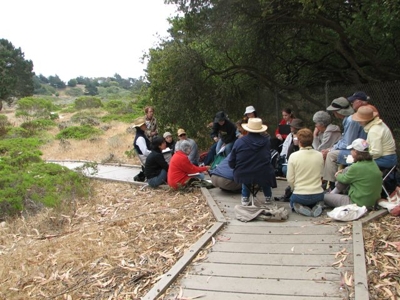
Congratulations and thank you to Dr. Peter Baye and John Muir Laws!
We’ve recently updated our donations page to accept automatic monthly donations. This is an easy way for you to provide sustained support for our campaigns. $5 per month provides significant support: it funds materials for 120 kids to participate in the GGNP Endangered Species Big Year.
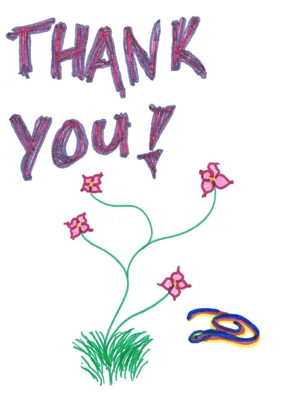
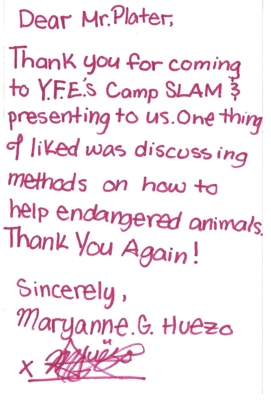
And if you donate $166.67 per month you’ll become a founding member of WEI!
We can’t do what we do without your support, and we are grateful for it. Thanks so much for all you do to protect people and the plants and animals that accompany us on Earth!
Check out our new donations page here.
The Wild Equity Institute’s Golden Gate National Parks Endangered Species Big Year is a finalist for Stayclassy.org’s Most Effective Awareness Campaign award for San Francisco. WEI is the only San Francisco Bay Area environmental organization nominated for any of Stayclassy.org’s awards this year.
You can help WEI win the award by voting at Stayclassy.org’s website. Voting is easy: just click on the Wild Equity Institute’s logo, scroll down to the bottom of the page, and click submit. After enter verification information (some of which you can skip) your vote will be tabulated.
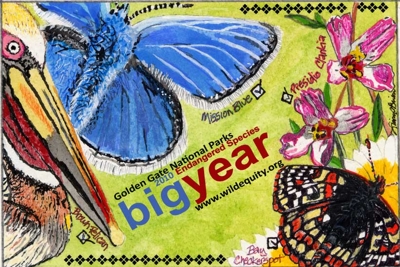
Thanks for your support! And it’s not too late to sign-up for your Big Year and compete for the $1,000 grand prize: click here to join.
The Wild Equity Institute is proud to offer a new fundraising partnership with Sungevity that is guaranteed to build a healthy and sustainable community for people and the plants and animals that accompany us on Earth!
For a limited time, when Wild Equity Institute members like you sign-up for a new, zero-down solar lease from Sungevity, the company will donate $500 to the Wild Equity Institute, while giving you an additional $500. That’s what we call a win-win!
Sungevity is a leading California home solar company that has recently introduced a new 10-year, fully guaranteed, home solar leasing solution which can help you save money on your electricity bill while decreasing your carbon footprint. Here is how it works:
- Sungevity installs solar panels on your home when you sign a lease.
- You pay Sungevity on a monthly basis for the lease, usually for less than your conventional electric bills.
- Sungevity owns, maintains, and insures the solar panels; you use the electricity generated to lower your utility bills.
- Sungevity pays you a $500 cash bonus after installation.
- Sungevity donates $500 to WEI for sending you their way.
To take advantage of this limited-time opportunity, all you need to do is visit the Wild Equity Institute’s special landing page on Sungevity’s website, enter your street address and answer a few simple questions to get your free installation iQuote.
Within 24 hours you’ll receive your free quote, and if you decide to sign a lease you and WEI will both have an extra $500 in the bank.
If you misplace this special link, you can also sign-up from Sungevity’s main page. Once you fill-in the requested information, you’ll be directed to a finishing page where you can enter a “referral code”: type WEI in this box. Don’t forget to enter the referral code or you won’t be eligible for the $500 bonus!
If you have any questions about the program, contact Brian Somers at Sungevity.
Thanks for all you do for people and the plants and animals that accompany us on Earth!

